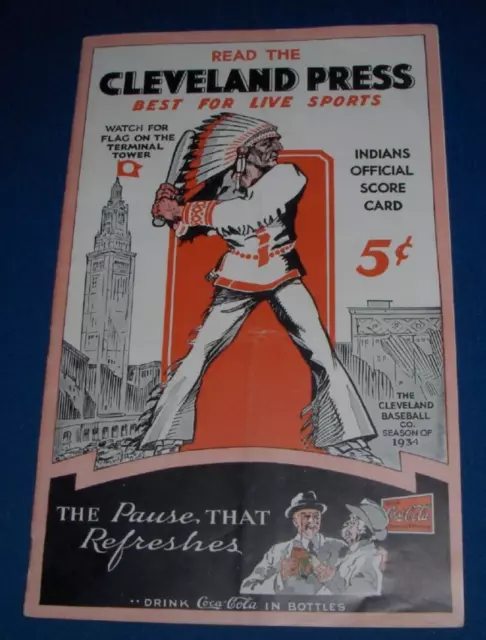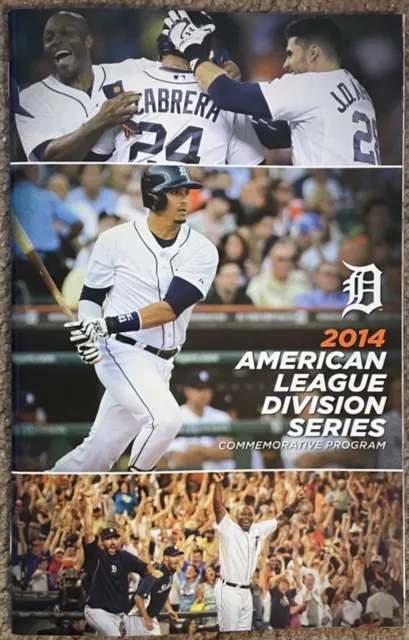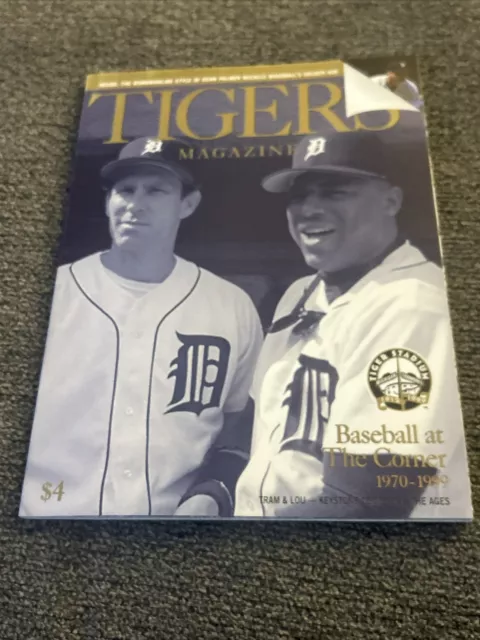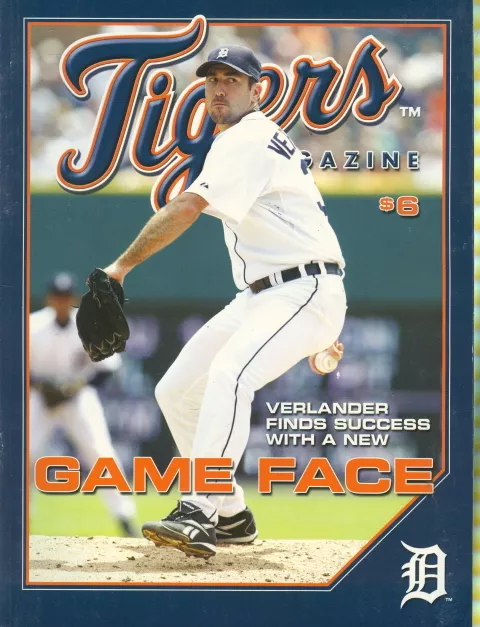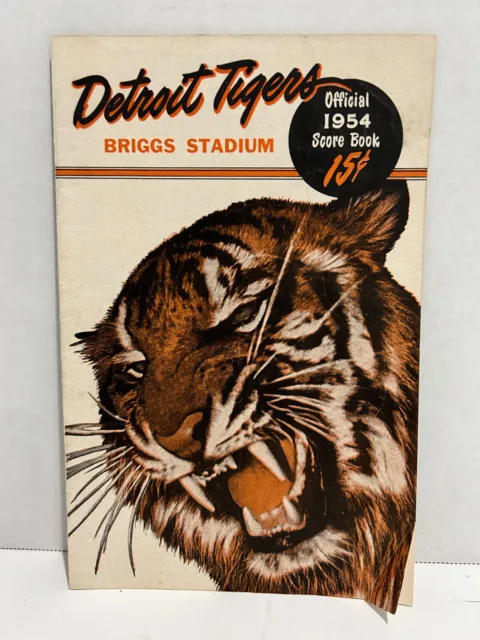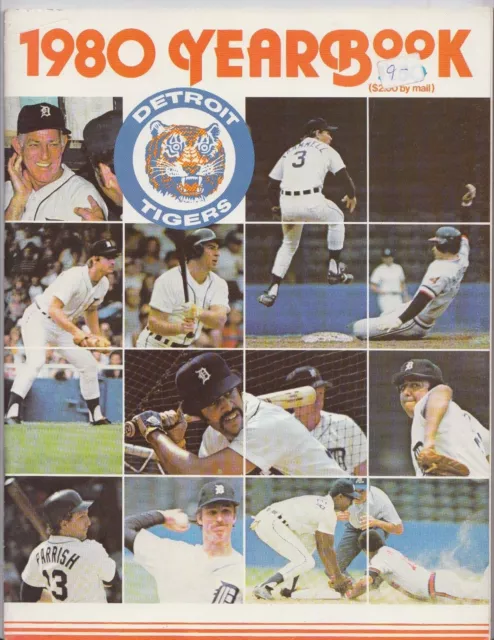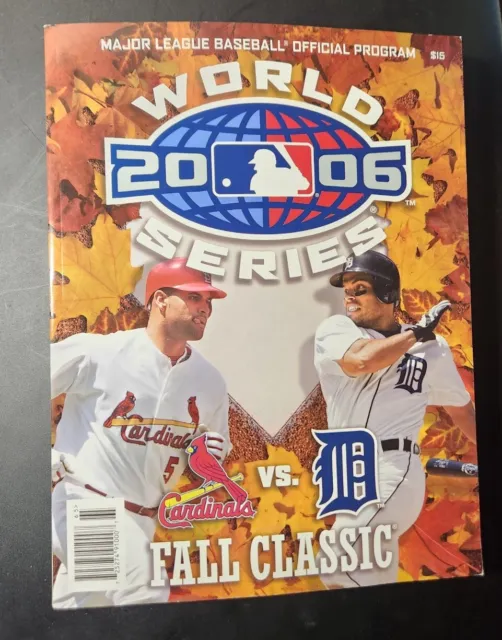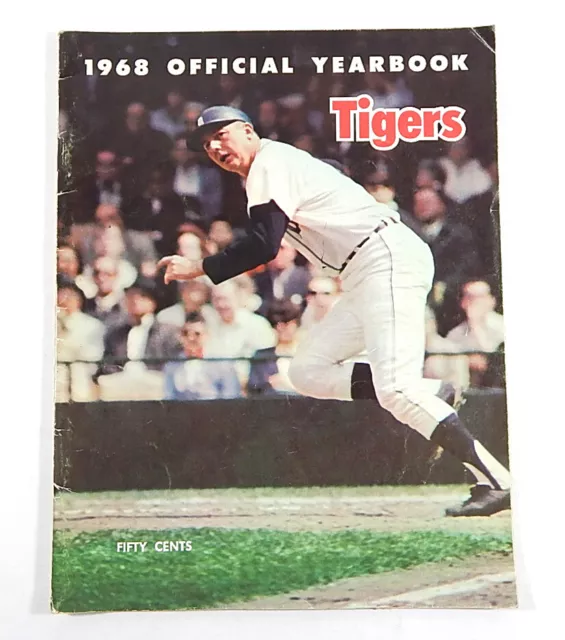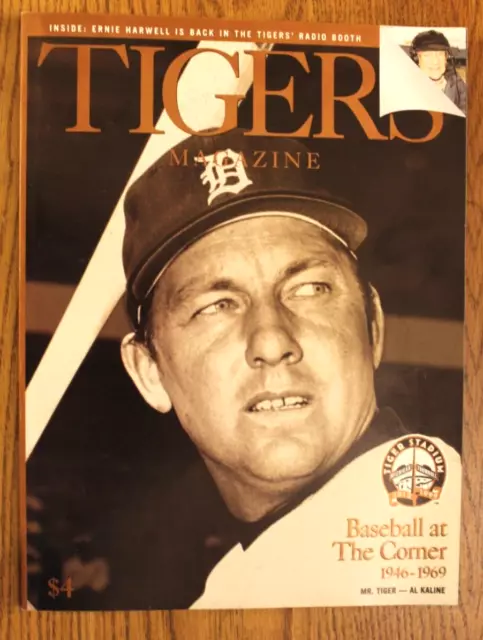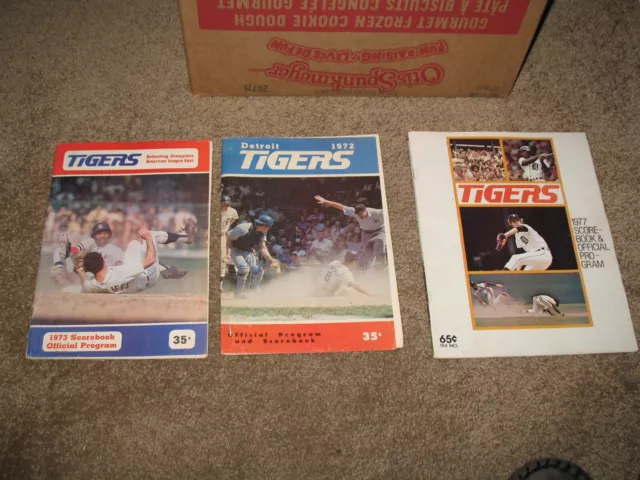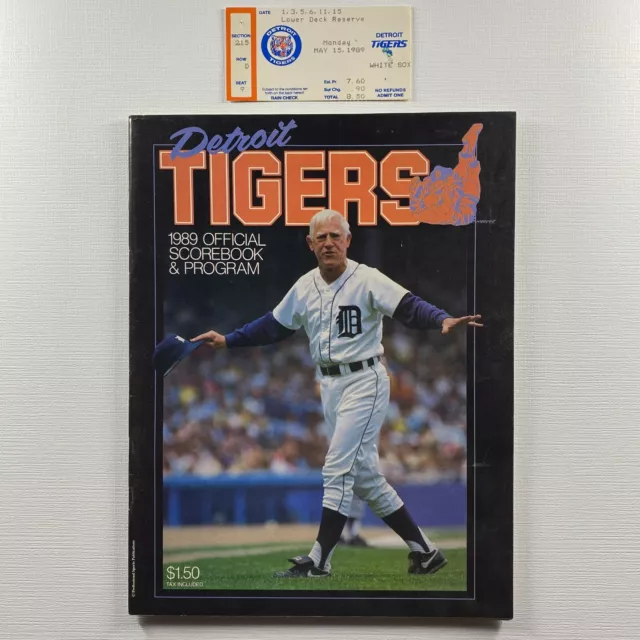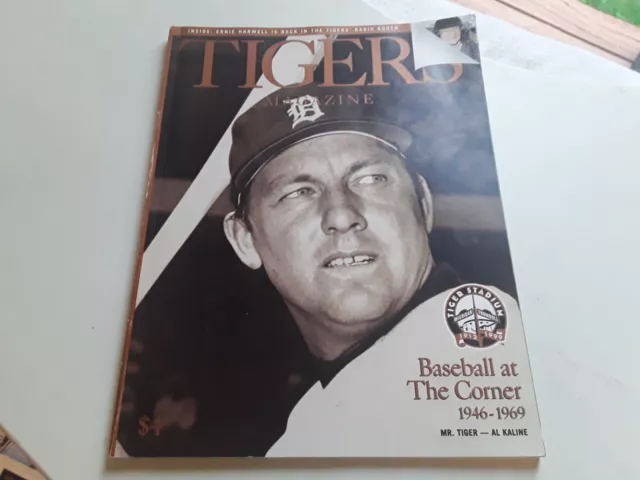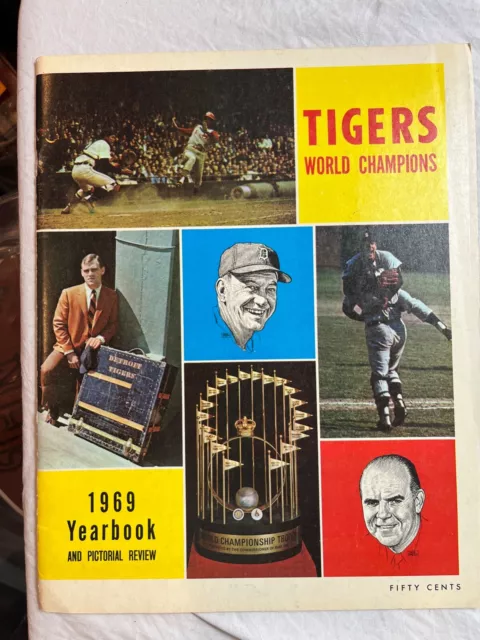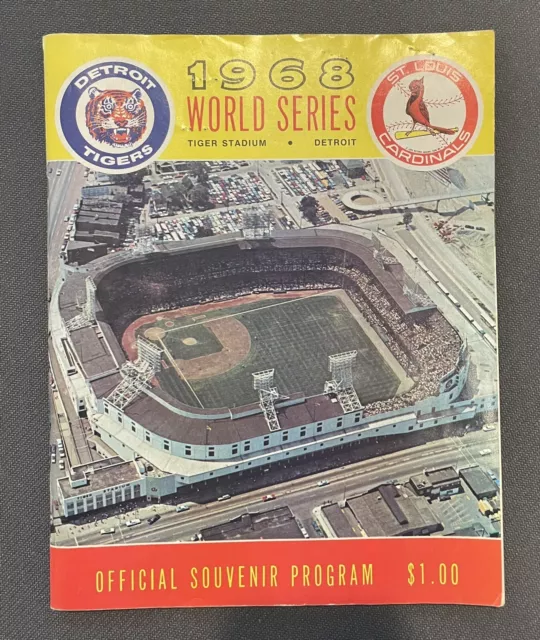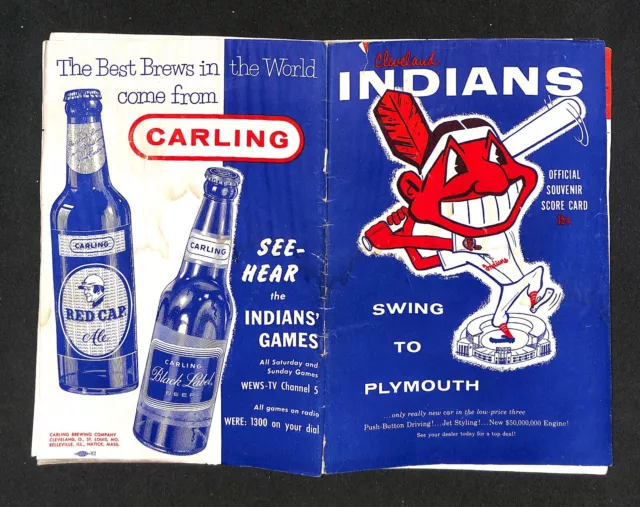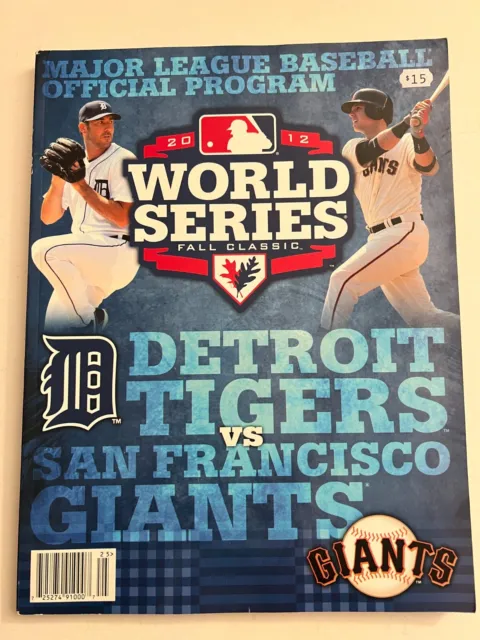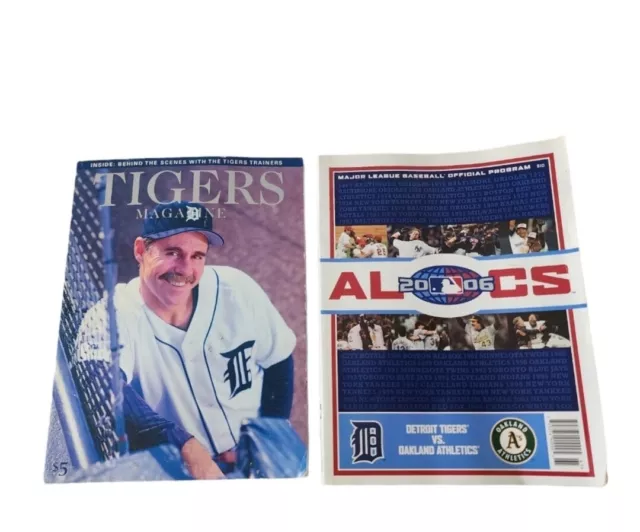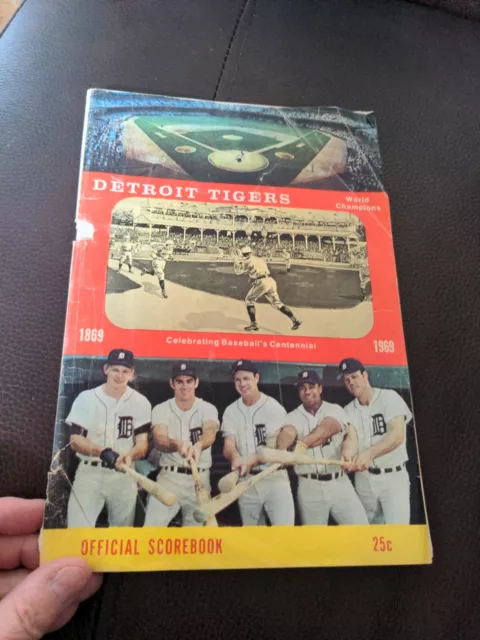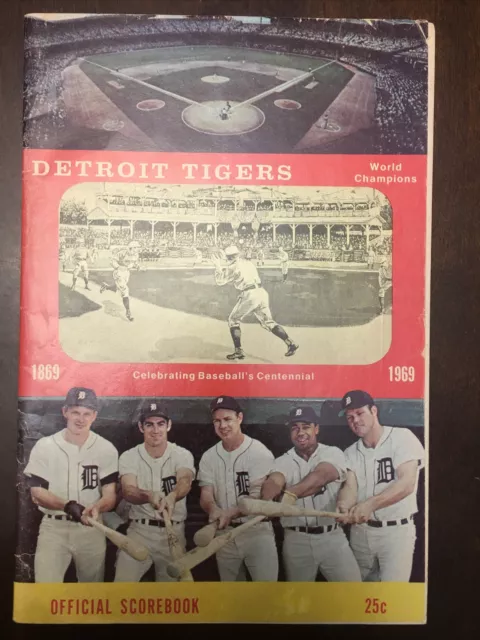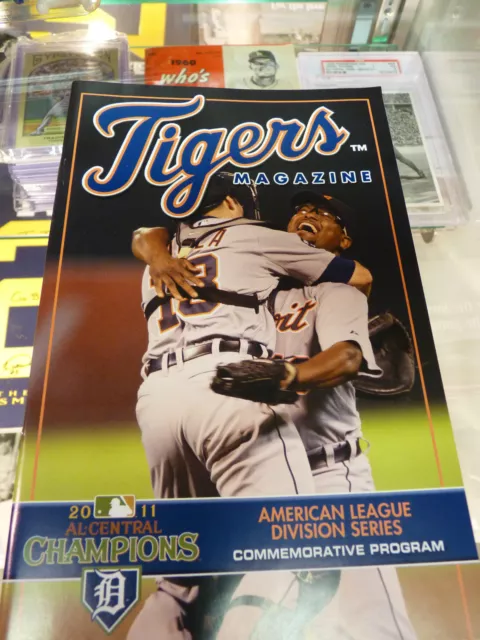Selling a 2011 Detroit Tigers Magazine ALDS Commemorative Program Comerica Park.
This item will be a great addition to Detroit Tigers collectors, MLB Post Season collectors and baseball and sports fans in general.
Size is 5.25 in x 8.5 in and is in mint condition. Excellent for capturing Tiger autographs.
Bid confident that we will ship this Detroit Tiger collectible Fast and Safe. HIgh resolution photo conveys condition and details.
If there are any questions, please contact us.
Payment method is PayPal.
Shipping & Handling costs are $3.95 for First Class Domestic. Will ship Fast and Safe.
Thank you
Detroit Tigers From Wikipedia, the free encyclopedia
| Detroit Tigers |
|---|
| 2014 Detroit Tigers season |
| Established | 1894 |
|---|
|
|---|
| |
| Major league affiliations |
|---|
- American League (1901 –present)
- Central Division (1998 –present)
|
|---|
| Current uniform |
| |
| Retired numbers | 2 · 5 · 6 · 11 · 16 · 23 · 42 |
|---|
| Colors |
|---|
|
| Name |
|---|
- Detroit Tigers (1894 –present)
|
| |
| Other nicknames |
|---|
- The Tigs, The Bengals, The Motor City Kitties
|
| Ballpark |
|---|
- Comerica Park (2000 –present)
- Tiger Stadium (1912–1999)
- a.k.a. Briggs Stadium (1938–1960)
- a.k.a. Navin Field (1912–1938)
- Bennett Park (1896–1911)
- Burns Park (Sundays, 1901–1902)
- Boulevard Park (1894–1895)
|
| Major league titles |
|---|
| World Series titles (4) | 1984 · 1968 · 1945 · 1935 |
| AL Pennants (11) | 2012 · 2006 · 1984 · 1968 · 1945 · 1940 · 1935 · 1934 · 1909 · 1908 · 1907 |
| | |
| Division titles (7) | Central: 2014 · 2013 · 2012 · 2011 East: 1987 · 1984 · 1972 |
| | |
| Wild card berths (1) | 2006 |
| |
| Front office |
|---|
| Owner(s) | Mike Ilitch |
|---|
| Manager | Brad Ausmus |
|---|
| General Manager | Dave Dombrowski |
|---|
The Detroit Tigers are a Major League Baseball team located in Detroit , Michigan . One of the American League 's eight charter franchises, the club was founded in Detroit in 1894 as part of the Western League . They are the oldest continuous one-name, one-city franchise in the American League . The Tigers have won four World Series championships (1935, 1945, 1968, and 1984), 11 American League Pennants (1907, 1908, 1909, 1934, 1935, 1940, 1945, 1968, 1984, 2006, and 2012), and four American League Central Division championships (2011, 2012, 2013, and 2014). The Tigers also won Division titles in 1972, 1984 and 1987 while members of the American League East . The team currently plays its home games at Comerica Park in Downtown Detroit .
The Tigers constructed Bennett Park at the corner of Michigan Avenue and Trumbull Avenue and began playing there in 1896 . In 1912 , the team moved into Navin Field, which was built on the same location. It was expanded in 1938 and renamed Briggs Stadium. It was renamed Tiger Stadium in 1961 and the Tigers played there until moving to Comerica Park in 2000.
Franchise history Main article: History of the Detroit Tigers
| | This section may be slanted towards recent events . Please try to keep recent events in historical perspective. (February 2011) |
The club is a charter member of the American League , one of four clubs (with the Boston Red Sox , Chicago White Sox and Cleveland Indians ) still located in its original city. Detroit is also the only member of the Western League , the AL's minor league predecessor, that remains in its original city under its original name. It was established as a charter member in 1894.
Western League: 1894–1900
The current Detroit club was a charter member when the Western League reorganized for the 1894 season . They originally played at Boulevard Park , sometimes called League Park. It was located on East Lafayette, then called Champlain Street, between Helen and East Grand Boulevard, near Belle Isle. In 1895 , owner George Vanderbeck decided to build Bennett Park at the corner of Michigan and Trumbull Avenues, which would remain their base of operations for the next 104 seasons. The first game at the corner was an exhibition on April 13, 1896. The team, now occasionally called the "Tigers", beat a local semi-pro team, known as the Athletics, 30–3. They played their first Western League game at Bennett Park on April 28, 1896, defeating the Columbus Senators 17–2.[1]
American League: 1901–present
The Tigers played their first game as a major league team at home against the Milwaukee Brewers on April 25, 1901, with an estimated 10,000 fans at Bennett Park.[2] After entering the ninth inning behind 13–4, the team staged a dramatic comeback to win 14–13. The team finished third in the eight-team league.
Eleven years later, an elegant stadium was constructed on the site of Bennett Park and named Navin Field for owner Frank Navin . In 1938, it was improved and named Briggs Stadium (for then-owner Walter Briggs, Sr. , who had purchased the team in 1935), and was subsequently renamed "Tiger Stadium" in 1961. Tiger Stadium was used by the Tigers until the end of the 1999 season. Since 2000, they have played in Comerica Park .
The Tigers Tiger Stadium , home of the Detroit Tigers from 1912–1999 at the corner of Michigan and Trumbull in the Corktown district of Detroit.
There are various legends about how the Tigers got their nickname . One involves the orange stripes they wore on their black stockings. Tigers manager George Stallings took credit for the name; however, the name appeared in newspapers before Stallings was manager. Another legend concerns a sportswriter equating the 1901 team's opening day victory with the ferocity of his alma mater, the Princeton Tigers .
Richard Bak, in his 1998 book, A Place for Summer: A Narrative History of Tiger Stadium , pp. 46–49, explains that the name originated from the Detroit Light Guard military unit, who were known as "The Tigers". They had played significant roles in certain Civil War battles and in the 1898 Spanish–American War . The baseball team was still informally called both "Wolverines" and "Tigers" in the news. The earliest known use of the name "Tigers" in the media was in the Detroit Free Press on April 16, 1895. Upon entry into the majors, the ballclub sought and received formal permission from the Light Guard to use its trademark . From that day forth, the team has been officially called the Tigers .
The Cobb era (1905–26) Ty Cobb in 1913.
In 1905 , the team acquired Ty Cobb , a fearless player with a mean streak, who came to be regarded as one of the greatest players of all time. The addition of Cobb to an already talented team that included Sam Crawford , Hughie Jennings , Bill Donovan and George Mullin quickly yielded results, as the Tigers won their first American League pennant in 1907. Jennings was the team's manager from 1907 to 1920.
1907 American League Champions Main article: 1907 Detroit Tigers season
Behind the hitting of outfielders Ty Cobb (.350) and Sam Crawford (.323), and the pitching of Bill Donovan and Ed Killian (25 wins each), the Tigers went 92–58 to win the AL pennant by 1.5 games over the Philadelphia Athletics . They moved on to their first World Series appearance in the team's seventh year of existence.
The Tigers lost in the 1907 World Series against the Chicago Cubs . Game 1 ended in a rare 3–3 tie, called due to darkness after 12 innings. The Tigers scored only three runs in the succeeding four games, never scoring more than one run in a game, and lost the Series, 4 games to none.
1908 American League Champions Main article: 1908 Detroit Tigers season
Due to a scheduling quirk that included the league's decision to not make up certain games, the 90–63 Tigers won the AL by just a half-game over the 90–64 Cleveland Naps . Cobb hit .324, while Sam Crawford hit .311 with 7 home runs, which was enough to lead the league in the "dead ball" era .
The Cubs , however, would deny Detroit the title again in the 1908 World Series , holding the Tigers to a .209 batting average for the series, which the Cubs won in five games. This would be the last World Series championship for the Cubs as of 2014.
1909 American League Champions Main article: 1909 Detroit Tigers season
Detroit posted a 98–54 season, winning the AL pennant by 3.5 games over the Athletics. Ty Cobb won the batting triple crown in 1909, hitting .377 with 9 home runs (all inside-the-park) and 107 RBIs. He also led the league with 76 stolen bases. George Mullin was the pitching hero, going 29–8 with a 2.22 ERA, while fellow pitcher Ed Willett went 21–10. Mullin's 11–0 start in 1909 was a Tiger record for 104 years, finally being broken by Max Scherzer in 2013 .[3]
It was hoped that a new opponent in the 1909 Series , the Pittsburgh Pirates , would yield different results. The Tigers performed better in the Fall Classic, taking Pittsburgh to seven games, but they were blown out 8–0 in the decisive game at Bennett Park.[4]
1910-1914
The Tigers dropped to third place in the American League in 1910 with an 86-68 record. They posted 89 wins in 1911 to finish second, but were still well behind a powerhouse Philadelphia Athletics team that won 101 games. The team sunk to a dismal sixth place in both the 1912 and 1913 seasons. A bright spot in 1912 was George Mullin pitching the franchise's first no-hitter in a 7–0 win over the St. Louis Browns on July 4, his 32nd birthday.
1912 also saw a bizarre incident on May 18. Ty Cobb had gone into the stands in a May 15 game to attack a fan that was abusing him, and was suspended. The Tigers protested the suspension by fielding a team of replacement players and some coaches, and wound up surrendering 24 runs on 26 hits.
Cobb, for his part, was sensational in this five-year stretch, posting batting averages of .383, .420, .409, .390 and .368, winning the AL batting title every year.
1915 Main article: 1915 Detroit Tigers season
In 1915 , the Tigers won a then-club record 100 games but narrowly lost the American League pennant to the Boston Red Sox who won 101 games. The 1915 Tigers were led by an outfield consisting of Ty Cobb, Sam Crawford, and Bobby Veach that finished #1, #2, and #3 in RBIs and total bases. Cobb also set a stolen base record with 96 steals in 1915 that stood until 1962, when it was broken by Maury Wills . Baseball historian Bill James has ranked the 1915 Tigers outfield as the greatest in the history of major league baseball. The only team in Tigers' history with a better winning percentage than the 1915 squad was the 1934 team that lost the World Series to the St. Louis Cardinals .
1916–1920
The Tigers dropped to third place in 1916 with an 87-67 record, and would remain mired in the middle of the AL standings the rest of the decade, never winning more than 80 games. In the late teens and into the twenties, Cobb continued to be the marquee player, though he was pushed by budding star outfielder Harry Heilmann , who went on to hit .342 for his career.
Hughie Jennings left the Tigers after the 1920 season, having accumulated 1,131 wins as a manager.[5] This stood as a Tiger record until 1992, when it was broken by Sparky Anderson . Cobb himself took over managerial duties in 1921, but during his six years at the helm, the Tigers topped out at 86 wins and never won a pennant.
1921 Main article: 1921 Detroit Tigers season
In 1921 , the Tigers amassed 1724 hits and a team batting average of .316—the highest team hit total and batting average in American League history. (The Elias Book of Baseball Records , 2008, p. 88) That year, outfielders Harry Heilmann and Ty Cobb finished #1 and #2 in the American League batting race with batting averages of .394 and .389. As early proof of the baseball adage that good pitching beats good hitting, the downfall of the 1921 Tigers was the absence of good pitching. The team ERA was 4.40, and they allowed nine or more runs 28 times. Without pitching to support the offense, the 1921 Tigers finished in sixth place in the American League at 71-82, 27 games behind the Yankees .
On August 19, 1921, Cobb collected his 3,000th career hit off Elmer Myers of the Boston Red Sox . Aged 34 at the time, he is still the youngest player to reach that milestone, also reaching it in the fewest at-bats (8,093).[6] [7]
1922-26
The Tigers continued to field good teams during Ty Cobb's tenure as player-manager, finishing as high as second in 1923 , but lack of quality pitching kept them from winning a pennant. In the 1925 season, the 38-year old Cobb nearly won his 12th batting title (or 13th depending on the source).[8] But he was again edged out by teammate Harry Heilmann, who collected six hits in a season-ending doubleheader to finish at .393 to Cobb's .389.
Cobb announced his retirement in November, 1926 after 22 seasons as a Tiger, though he would return to play two more seasons with the Philadelphia Athletics .
The Tigers break through (1927–40) Hall of Famer Hank Greenberg 1927–1933
Though the Tigers struggled with mediocre records in the seven years following Cobb's departure, they were building a solid foundation, adding slugging first baseman Hank Greenberg and pitchers Tommy Bridges and Schoolboy Rowe to a lineup that already included consistent Charlie Gehringer , "The Mechanical Man", at second base.
In 1927 , Harry Heilmann flirted with a .400 batting average all year, eventually finishing at .398 and winning his fourth AL batting title.
Following the 1933 season, the Tigers added perhaps the final piece of the puzzle, acquiring catcher "Black Mike" Mickey Cochrane from the Philadelphia Athletics to serve as player-manager.
1934 American League Champions Main article: 1934 Detroit Tigers season
The Tigers won the 1934 AL Pennant with a 101–53 record, at the time a team record for wins, and still the best win percentage (.656) in team history. The Tigers infield (Hank Greenberg and Charlie Gehringer, along with shortstop Billy Rogell and third baseman Marv Owen ) accumulated 769 hits during the season, with Gehringer (214 hits, .356 average) leading the way. Schoolboy Rowe led a strong pitching staff, winning 16 straight decisions at one point of the season and finishing with a 24–8 record.
The Tigers would fall in the 1934 World Series in seven games to the "Gashouse Gang " St. Louis Cardinals . After winning a tight battle in Game 5 with a 3–1 decision over Dizzy Dean , Detroit took a 3–2 series lead, but would lose the next two games at Navin Field (Tiger Stadium). For the second time in a World Series Game 7, Detroit folded. St. Louis scored seven times in the third inning off starter Elden Auker and a pair of relievers, while Dizzy Dean baffled the Tiger hitters en route to an 11–0 victory. The final game was marred by an ugly incident. After spiking Tiger third baseman Marv Owen in the sixth inning, the Cardinals' Joe "Ducky" Medwick had to be removed from the game for his own safety by Commissioner Kenesaw Mountain Landis after being pelted with fruit and garbage from angry fans in the large temporary bleacher section in left field.
1935 World Series Champions Main article: 1935 Detroit Tigers season
The Tigers 1935 lineup featured four future Hall of Famers (Hank Greenberg , Mickey Cochrane , Goose Goslin and Charlie Gehringer ). Though they didn't challenge the 1934 team's 101 wins, their 93–58 record was good enough to give them the AL pennant by three games over the New York Yankees. Hank Greenberg was named AL MVP after hitting .328 and leading the league in home runs (36), extra-base hits (98) and RBIs (170). Incredibly, Greenberg's RBI total was 51 higher than the next closest player (Lou Gehrig , with 119). The Tigers also got strong contributions from Charlie Gehringer (.330), Mickey Cochrane (.319) and starting pitchers Tommy Bridges (21–10) and Elden Auker (18–7).
the Tigers finally won their first World Series , defeating the Chicago Cubs , 4 games to 2. Game 6 concluded with Goslin's dramatic walk-off RBI single, scoring Cochrane for a 4–3 victory.
After team owner Frank Navin died during the 1935 season, plumbing fixture manufacturer Walter Briggs, Sr. took control of the team.
1936–1939
Despite being forecast to win the American League title again in 1936 [9] the Tigers fell to a distant second place behind the New York Yankees both that season and in 1937. In 1938 and 1939, the team fell to fourth place with identical 84-70 records each year. Hank Greenberg nevertheless provided some excitement for Tiger fans in 1938 by challenging the single-season home run record held by Babe Ruth (60). Hank went into the season's final weekend against the Cleveland Indians with 58 home runs, tied with Jimmie Foxx for the most by a right-handed batter, but he failed to homer on Saturday or Sunday.[10]
At the close of the 1938 season, the Tigers presciently held out doubts about a pennant in 1939, but figured that 1940 would be their year.[11]
1940 American League Champions Main article: 1940 Detroit Tigers season
In a tight three-team race, the 90–64 Tigers won the AL pennant by one game over the Cleveland Indians and two games over the New York Yankees . Prior to the season, first baseman Hank Greenberg was persuaded to move to left field to make room for slugging first baseman Rudy York . The move proved successful. York hit .316 with 33 home runs and 134 RBIs. Greenberg batted .340 and slammed 41 home runs while driving in 150. Hank won his second AL MVP award, becoming the first major leaguer to win the award at two different fielding positions. Charlie Gehringer, now 37, batted .313 while collecting 101 walks and scoring 108 runs.
Bobo Newsom was the ace of the Tiger pitching staff in 1940, going 21–5 with a 2.83 ERA. An unlikely hero on the mound this season was 30-year old rookie Floyd Giebell . Making just his third major league start on September 27, Giebell was called upon to pitch the pennant-clinching game against the legendary Bob Feller of the Indians. Feller surrendered just three hits, one being a 2-run homer by Rudy York, while Giebell blanked the Tribe for a 2–0 victory.[12]
The Tigers lost the 1940 World Series to the Cincinnati Reds in seven games. Despite a heroic effort by Bobo Newsom, the Tigers came up short in the deciding game, losing 2–1. Newsom's father had died in a Cincinnati hotel room after watching his son win Game 1. An inspired Bobo won Game 5 and pitched Game 7 on just one day's rest. This was the third time the Tigers had lost a World Series in a deciding seventh game.
The war years (1941-45)
With Hank Greenberg serving in World War II for all or parts of the 1941-44 seasons, the Tigers struggled to recapture the glory of 1940. They finished no higher than fifth place in 1941-43, but did manage a second place finish in 1944 , largely on the strength of pitchers Hal Newhouser and Dizzy Trout , who won 29 and 27 games respectively. Newhouser, who was 29-9 with a 2.22 ERA, won the first of his two consecutive AL MVP awards this season. The Tigers took over first place on September 18, but would finish one game behind the St. Louis Browns for the AL Pennant.
1945 World Series Champions Main article: 1945 Detroit Tigers season
With the end of World War II and the timely return of Hank Greenberg and others from the military, the 88–65 Tigers took the 1945 American League pennant by just 1.5 games over the Washington Senators . Hal Newhouser became the first pitcher in the history of the American League to win the MVP Award in two consecutive seasons.[13] "Prince Hal" won the pitching triple crown , leading the AL in wins (25, against nine losses), ERA (1.81) and strikeouts (212).
With Newhouser, Virgil Trucks and Dizzy Trout on the mound and Greenberg leading the Tiger bats, Detroit responded in a World Series Game 7 for the first time, staking Newhouser to a 5–0 lead before he threw a pitch en route to a 9–3 victory over the Cubs . Because many baseball stars had not yet returned from the military, some baseball scholars have deemed the '45 Series to be among the worst-played contests in Series history. For example, prior to the Series, Chicago sportswriter Warren Brown was asked who he liked, and he answered, "I don't think either one of them can win it!"[14] But the Cubs had no answer to Greenberg, who hit the Tigers' only two home runs of the Series and drove in seven, and the Series went Detroit's way.
A long drought (1946–67) 1946–50
After their 1945 Series win, the Tigers continued to have winning records for the remainder of the decade, finishing second in the AL three times but never winning the pennant. The 1950 season was particularly frustrating, as the Tigers posted a 95-59 record for a .617 winning percentage, the fourth best in team history at the time. But they finished that season three games behind a strong New York Yankees team that went on to sweep the Philadelphia Phillies in the World Series.
During the 1946 season, the Tigers acquired George Kell , a third baseman who was a 10-time all-star and future Hall of Famer. He batted over .300 in eight straight seasons (1946–53), and finished with a career .306 mark. Kell won a batting title in a very close race with Ted Williams in 1949 , going 2-for-3 on the last day of the season to edge out the Red Sox slugger, .3429 to .3427.
1951–60
Over the next ten years, the Tigers sank to the middle and lower ranks of the American League. The team had only three winning records over this span and never finished higher than fourth place. The last-place 1952 team went 50-104 (.325), which was the worst season in Tigers history until the 2003 team lost 119 games. Despite the dismal season, starter Virgil Trucks threw two no-hitters in 1952, only the third time in major league history that a pitcher had accomplished that feat.[15] Also, team owner Walter Briggs, Sr. died in 1952. His son Walter Briggs, Jr. inherited the team, but he was forced to sell it in 1956 to broadcast media owners John Fetzer and Fred Knorr .
Notwithstanding Detroit's fall in the standings, the decade saw the debut of outfielder Al Kaline in 1953. One of the few Major League players who never played a day in the minor leagues, he would hit over .300 nine times in his career. He also made 15 All-Star teams, won 10 Gold Gloves, and featured one of the league's best arms in right field. In 1955, the 20-year old Kaline hit .340 to became the youngest-ever batting champion in major league history.[16]
1958 saw the Tigers become the 15th of the then 16 MLB teams to field an African-American player. In the Tigers' case, it was an Afro-Caribbean player, Ozzie Virgil, Sr. who finally broke the team's color barrier. Only the Boston Red Sox trailed the Tigers in integrating their roster .
1961 Main article: 1961 Detroit Tigers season
As the American League expanded from 8 to 10 teams, Detroit began its slow ascent back to success with an outstanding 1961 campaign. The Tigers won 101 games, a whopping 30-game improvement over the 71-83 1960 team , but still finished eight games behind the Yankees . This marked one of the few times in major league history that a team failed to reach the postseason despite winning 100 or more games, though it had happened once before to the Tigers (1915). First baseman Norm Cash had the best batting average in the American League, a remarkably high .361, while teammate Al Kaline finished second. Cash never hit over .286 before or after the '61 season, and would later say of the accomplishment: "It was a freak. Even at the time, I realized that."[17] Cash's plate heroics, which also included 41 home runs and 132 RBI, might have earned him MVP honors that season were it not for New York's Roger Maris bashing a record 61 homers the same year. Cash also drew 124 walks that season for a league-leading .487 on-base percentage.
The 1961 club featured two nonwhite starters, Jake Wood and Bill Bruton , and later in the 1960s, black players such as Willie Horton , Earl Wilson , and Gates Brown would contribute to Detroit's rise in the standings.
1962–66
As a strong nucleus developed, Detroit repeatedly posted winning records throughout the 1960s. Pitchers Mickey Lolich and Denny McLain entered the rotation during the middle of the decade, with outfielders Willie Horton (1963), Mickey Stanley (1964) and Jim Northrup (1964) also coming aboard at this time.
The team managed a third-place finish during a bizarre 1966 season , in which manager Chuck Dressen and acting manager Bob Swift were both forced to resign their posts because of health problems. Thereafter, Frank Skaff took over the managerial reins until the end of the season. Both Dressen and Swift died during the year – Dressen in August because of a kidney infection , Swift in October due to cancer. Skaff was replaced by Mayo Smith in 1967, perhaps the last step before World Series contention.
1967 Main article: 1967 Detroit Tigers season
Indeed, in 1967 the Tigers were involved in one of the closest pennant races in history. Because of rainouts, the Tigers were forced to play back-to-back doubleheaders against the California Angels over the final two days of the season. They needed to sweep the doubleheader on the last day of the season to force a one-game playoff with the Boston Red Sox . The Tigers won the first game but lost the second, giving the Red Sox the flag with no playoff. Detroit finished the season at 91–71, a single game behind Boston. Starter Earl Wilson , acquired the previous season from the Red Sox, led the Tigers with 22 wins and would form a strong 1–2–3 combination with Denny McLain and Mickey Lolich over the next few years.
1968–72 Glory in '68 (1968 World Series Champions) Main article: 1968 Detroit Tigers season
The Tigers finally returned to the World Series in 1968 . The team grabbed first place from the Baltimore Orioles on May 10 and would not relinquish the position, clinching the pennant on September 17 and finishing with a 103–59 record. In a year that was marked by dominant pitching, starter Denny McLain went 31–6 (with a 1.96 ERA), the first time a pitcher had won 30 or more games in a season since the St. Louis Cardinals ' Dizzy Dean accomplished the feat in 1934; no pitcher has accomplished it since. McLain was unanimously voted American League Most Valuable Player and Cy Young Award winner for his efforts.
1968 World Series Main article: 1968 World Series
In the 1968 World Series, the Tigers met the defending World Series champion St. Louis Cardinals , led by starter Bob Gibson (who had posted a record 1.12 ERA during the regular season) and speedy outfielder Lou Brock . This was the first time the Tigers and Cardinals had met in the World Series since 1934, when as it was said, they were choked by the Gashouse Gang . The series was predicated with a bold decision by manager Mayo Smith to play center fielder Mickey Stanley at shortstop, replacing the slick fielding but weak hitting of Ray Oyler . Stanley had never played shortstop before, but was a gold glover in the outfield and an excellent athlete. Smith started him at short for the final nine games of the regular season and all seven World Series games, with Oyler only appearing as a late-inning defensive replacement. This allowed Smith to play an outfield of Willie Horton , Jim Northrup and Al Kaline in every Series game.
In Game 1, Gibson completely shut down the Detroit lineup, striking out 17 batters, still a World Series record, en route to an easy 4–0 win. However, due in no small part to pitcher Mickey Lolich 's victories in Games 2 and 5, the Tigers climbed back into the Series. Many fans believe the turning point in the Series came in the fifth inning of Game 5, with the Tigers down three games to one, and trailing in the game, 3–2. Left fielder Willie Horton made a perfect throw to home plate to nail Lou Brock (who tried to score from second base standing up), as catcher Bill Freehan blocked the plate with his foot. The Tigers came back with three runs in the seventh to win that game, 5–3, and stay alive in the Series. The Cardinals would not threaten to score the rest of this game, and scored only two more meaningless runs over the remainder of the series. In Game 6, McLain ensured a Game 7 by notching his only win of the Series, a 13–1 blowout, despite pitching on only two days' rest.
In Game 7 at Busch Memorial Stadium , Lolich, also pitching on two days' rest, faced Gibson. Both men pitched brilliantly, putting zeros up on the scoreboard for much of the game. In the bottom of the sixth inning, the Cardinals looked primed to take the lead as Lou Brock singled to lead off the inning, only to be promptly picked off first base by Lolich. One out later, Curt Flood followed with another single, and was also picked off first by Lolich. In the top of the seventh, an exhausted Gibson finally cracked, giving up two-out singles to Norm Cash and Willie Horton. Jim Northrup then struck the decisive blow, lashing a triple to center field over the head of Flood, who appeared to misjudge how hard the ball was hit. That scored both Cash and Horton; Northrup himself was then brought home by a Bill Freehan double. Detroit added an insurance run in the ninth. A solo home run by Mike Shannon was all the Cardinals could muster against Lolich as the Tigers took the game, 4–1, and the Series, 4–3. For his three victories that propelled the Tigers to the World championship, Lolich was named the World Series Most Valuable Player . Through 2013, Lolich is the last player to have three complete-game victories in a single World Series.[18] Also, at the time, Detroit was only the third team ever to come back from being down 3 games to 1 and win a World Series title. The others were the 1925 Pittsburgh Pirates (defeated Washington Senators) and the 1958 New York Yankees (defeated Milwaukee Braves). Since the advent of divisional baseball in 1969 there have been quite a few post-season 3-1 comebacks.
1969–71
1969 saw further expansion as both leagues realigned into two divisions of six teams, and the Tigers were placed in the American League East . That year, Detroit failed to defend its '68 title, despite Denny McLain having another outstanding season with a 24-9 campaign, earning him his second straight Cy Young Award (co-winner with Baltimore's Mike Cuellar ). The Tigers' 90 wins placed them a distant second in the division to a very strong Baltimore Orioles team , which had won 109 games.
McLain, suspended three times in 1970 , was only 3-5 that season and was traded after the season was done. Mayo Smith was also let go after a disappointing fourth-place finish in 1970 , to be replaced by Billy Martin . In a playing career that was primarily spent with the New York Yankees , Martin played his final games with the Minnesota Twins and stayed in that organization after his retirement. He managed the Twins to an AL West Division title in 1969 , but was fired after that season due to rocky relationships with his players which included a legendary fight with pitcher Dave Boswell in an alley behind Detroit's Lindell AC sports bar.[19] He would spend the 1970 season out of baseball.
After the 1970 regular season, Denny McLain was part of a seven-player deal with the Washington Senators in what would turn out to be a heist for Detroit. The Tigers acquired pitcher Joe Coleman , shortstop Eddie Brinkman and third baseman Aurelio Rodríguez . Coleman paid immediate dividends for Detroit, winning 20 games in 1971 , while McLain went 10-22 for the Senators and was out of baseball by age 29.
Martin's Tigers posted 91 wins in 1971 , but again had to settle for a second-place finish behind the Orioles, who won 101 games to take their third straight AL East Division crown. The season was highlighted by Mickey Lolich's 308 strikeouts, which led the AL and is still the Detroit Tigers single-season record as of 2014. Lolich also won 25 games and posted a 2.92 ERA while throwing an incredible 376 innings and completing 29 of his 45 starts.
1972 AL East Champions Main article: 1972 Detroit Tigers season
The Tigers post-1970 acquisitions (Joe Coleman, Eddie Brinkman and Aurelio Rodríguez) all played critical roles in 1972 , when the Tigers captured their first AL East division title. Oddities of the schedule due to an early-season strike allowed the 86-70 Tigers to win the division by just ½ game, just as they had won the pennant in 1908. Brinkman was named Tiger of the Year by the Detroit Baseball Writers, despite a .203 batting average, as he committed just 7 errors in 728 chances (.990 fielding percentage) and had a 72-game errorless streak during the season.[20] Mickey Lolich was his steady self for the Tigers, winning 22 games with a sparkling 2.50 ERA, while Coleman won 19 and had a 2.80 ERA. Starter Woodie Fryman , acquired on August 2, was the final piece of the puzzle as he went 10–3 over the last two months of the regular season and posted a minuscule 2.06 ERA. Fryman was also the winning pitcher in the division-clinching game against the Boston Red Sox , a 3-1 victory on October 3.
1972 ALCS Main article: 1972 American League Championship Series
In the 1972 American League Championship Series, Detroit faced the American League West division champion Oakland Athletics , who had become steadily competitive ever since the 1969 realignment. In Game 1 of the ALCS in Oakland, Mickey Lolich , the hero of '68, took the hill and allowed just one run over nine innings. The Athletics' ace, Catfish Hunter , matched Lolich, and the game went into extra innings. Al Kaline hit a solo homer to break a 1–1 tie in the top of the 11th inning, only to be charged with a throwing error on Gonzalo Marquez 's game-tying single in the bottom half of the frame that allowed Gene Tenace to score the winning run. Blue Moon Odom shut down Detroit 5–0 in Game 2. The end of Game 2 was marred by an ugly incident in which Tiger reliever Lerrin Lagrow hit A's shortstop and leadoff hitter Bert Campaneris on the ankle with a pitch. An angered Campaneris flung the bat at Lagrow, and Lagrow ducked just in time for the bat to sail over his head. Both benches cleared, and though no punches were thrown, both Lagrow and Campaneris were suspended for the remainder of the series. It was widely thought (and years later confirmed by Lagrow) that Martin had ordered the pitch that hit Campaneris, who had three hits, two stolen bases and two runs scored in the game.[21]
As the series shifted to Detroit, the Tigers caught their stride. Joe Coleman held the A's scoreless on seven hits in Game 3, striking out 14 batters in a 3–0 Tiger victory. Game 4 was another pitchers' duel between Hunter and Lolich, resulting again in a 1-1 tie at the end of nine innings. Oakland scored two runs in the top of the 10th and put the Tigers down to their last three outs. Detroit pushed two runs across the plate to tie the game before Jim Northrup came through in the clutch again. His single off Dave Hamilton scored Gates Brown to give the Tigers a 4-3 win and even the series at two games apiece.
A first-inning run on an RBI ground out from Bill Freehan , set up by a Gene Tenace passed ball that allowed Dick McAuliffe to reach third, gave Detroit an early lead in the deciding fifth and final game in Detroit. Reggie Jackson 's steal of home in the second inning tied it up, though Jackson was injured in a collision with Freehan and had to leave the game. Tenace's two-out single to left field plated George Hendrick to give Oakland a 2–1 lead in the fourth inning. The run was controversial to many Tiger fans, as Hendrick was ruled safe at first base two batters prior to the Tenace hit. Hendrick appeared to be out by two steps on a grounder to short, but umpire John Rice ruled that Norm Cash pulled his foot off first base. Replays and photos, however, show that Cash did not pull his foot.[22] Thanks to that play and four innings of scoreless relief from Vida Blue , the A's took the American League pennant and a spot in the World Series .
A slow decline (1973–78)
The 1973 season saw the Tigers drop to third place in the division, with an 85-77 record. Joe Coleman posted another 23 wins, but the other Tiger starters had subpar seasons. Willie Horton hit .316, but injuries limited him to just 111 games. Jim Northrup posted the best batting average of his career (.307) but was inexplicably limited to part-time duty (119 games played), which Northrup attributed to an ongoing feud with Billy Martin that had actually started in the 1972 ALCS. Northrup even proclaimed to the press that Martin "took the fun out of the game."[22] Martin did not survive the 1973 season as manager. He was fired that September after ordering his pitchers to throw spitballs (and telling the press that he did so) in protest of opposing Cleveland Indians pitcher Gaylord Perry , whom Martin was convinced was doing the same. Base coach Joe Schultz served as interim manager for the final 28 games of the season.
A bright spot for the Tigers in 1973 was relief pitcher John Hiller , who marked his first full season since suffering a heart attack in 1971 by collecting a league-leading 38 saves and posting a brilliant 1.44 ERA. Hiller's saves total would stand as a Tiger record until 2000 , when it was broken by Todd Jones ' 42 saves. (Jones' record would later be broken by Jose Valverde 's 49 saves in 2011.)
The Tigers spent the remainder of the 1970s in the middle or lower ranks of the AL East. In 1974 , Ralph Houk , who managed the dominant Yankee teams of the early 1960s, was named manager of the Tigers. "The Major" served in that capacity for five full seasons, through the end of the 1978 season . The roster of players who played under Houk were mostly aging veterans from the 1960s, whose performance had slipped from their peak years. The Tigers did not have a winning season from 1974 to 1977, and their 57 wins in the 1975 season was the team's lowest since 1952 . Perhaps the biggest signal of decline for the Tigers was the retirement of Kaline following the 1974 season, after he notched his 3,000th career hit . Kaline finished with 3,007 hits and was elected to the Baseball Hall of Fame in his first year of eligibility in 1980.
1976: The Year of The Bird Main article: 1976 Detroit Tigers season
Tiger fans were provided a glimmer of hope when 21-year old rookie Mark Fidrych made his debut in 1976 . Fidrych, known as "The Bird", was a colorful character known for talking to the baseball and other eccentricities. During a game against the Yankees , Graig Nettles responded to Fidrych's antics by talking to his bat. After making an out, he later lamented that his Japanese-made bat didn't understand him. Fidrych entered the All-Star break at 9-2 with a 1.78 ERA, and was the starting pitcher for the American League in the All Star Game played that year in Philadelphia to celebrate the American Bicentennial . He finished the season with a record of 19–9 and an American League-leading ERA of 2.34. Fidrych, the AL Rookie of the Year, was one of the few bright spots that year with the Tigers finishing next to last in the AL East in 1976.
Aurelio Rodríguez won the Gold Glove Award for 1976 at third base, snapping a 16-season streak in which Hall of Famer Brooks Robinson had won every award at the position.
1977-78
Injuries to his knee, and later his arm, drastically limited Fidrych's appearances in 1977–78. Perhaps more important, however, was the talent coming up through the Tigers farm system at the time. Jack Morris , Lance Parrish , Alan Trammell and Lou Whitaker all made their Tiger debuts in 1977, and would help the team to 88 wins in 1978 , the only winning season under Houk.
The "Bless You Boys" era (1979–87)
Houk's immediate successor as Tiger manager in 1979 was Les Moss , but Moss would only last until June of that year. From June 14, 1979 until the end of the 1995 season, the team was managed by George "Sparky" Anderson , one of baseball's winningest managers and owner of two World Series rings as manager of the Cincinnati Reds during their peak as The Big Red Machine . When Anderson joined the Tigers in 1979 and assessed the team's young talent, he boldly predicted that it would be a pennant winner within 5 years.[23]
Acerbic sports anchor Al Ackerman of Detroit's WXYZ-TV (and later WDIV-TV ) initiated the phrase "Bless You Boys" whenever the Tigers would win a game—sarcastically at first, because the team still wasn't winning enough to be respectable. But the Tigers became steadily competitive, with winning records in each of Anderson's first four full seasons (1980–83), and Ackerman's phrase would take on a new meaning in 1984.
The Roar Of 84: 1984 World Series Champions Main article: 1984 Detroit Tigers season
As in 1968, the Tigers' next World Series season would be preceded by a disappointing second-place finish, as the 1983 Tigers won 92 games to finish six games behind the Baltimore Orioles in the AL East.
The first major news of the 1984 season actually came in late 1983, when broadcasting magnate John Fetzer , who had owned the club since 1957, sold the team to Domino's Pizza founder and CEO Tom Monaghan .[24] The sale of the franchise caught everyone by surprise, as the negotiations culminating in the sale of the franchise were conducted in total secrecy. There were no rumors or even speculation that Fetzer had put the franchise up for sale.
The 1984 team got off to a 9-0 start highlighted by Jack Morris tossing a nationally-televised no-hitter against Chicago in the fourth game of the season. They stayed hot for most of the year, posting a 35-5 record over their first forty games and cruising to a franchise-record 104 victories. The Tigers led the division from opening day until the end of the regular season and finished a staggering 15 games ahead of the second-place Toronto Blue Jays . Closer Willie Hernández , acquired from the 1983 NL champion Philadelphia Phillies in the offseason, won both the AL Cy Young and AL Most Valuable Player awards, a rarity for a relief pitcher.
1984 ALCS Main article: 1984 American League Championship Series
The Tigers faced the Kansas City Royals in the American League Championship Series, which would prove to be no contest, not surprising given the fact the Royals won 20 fewer games during the season. In Game 1, Alan Trammell, Lance Parrish and Larry Herndon went deep to crush the Royals 8–1 at Royals Stadium (now Kauffman Stadium ). In Game 2, the Tigers scored twice in the 11th inning when Johnny Grubb doubled off Royals closer Dan Quisenberry en route to a 5–3 victory. The Tigers completed the sweep at Tiger Stadium in Game 3. Marty Castillo 's third-inning RBI fielder's choice would be all the help Detroit would need. Milt Wilcox outdueled Charlie Leibrandt , and after Hernandez got Darryl Motley to pop out to preserve the 1–0 win, the Tigers were returning to the World Series.
1984 World Series Main article: 1984 World Series
In the NLCS , a San Diego rally from 2–0 down prevented a fifth Cubs-Tigers series and meant the Tigers would open the 1984 World Series against the San Diego Padres in Trammell's hometown.
In Game 1, Larry Herndon hit a two-run home run that gave the Tigers a 3–2 lead. Morris pitched a complete game with 2 runs on 8 hits, and Detroit drew first blood. The Padres evened the series the next night despite pitcher Ed Whitson being chased after pitching two-thirds of an inning and giving up three runs on five Tiger hits. Tiger starter Dan Petry exited the game after four and one-third innings when Kurt Bevacqua 's three-run homer gave San Diego a 5–3 lead they would hold onto.
When the series shifted to the Motor City, the Tigers took command. In Game 3, a two-out rally in the second inning, highlighted by Marty Castillo's 2-run homer, led to four runs and the yanking of Padre starter Tim Lollar after one and two-thirds innings. The Padres, plagued by poor starting pitching throughout the series, never recovered and lost 5–2. Eric Show continued the parade of bad outings in Game 4, getting bounced after two and two-thirds innings after giving up home runs to Series MVP Trammell in his first two at-bats. Trammell's homers held up with the help of another Morris complete game, and the Tigers' 4–2 win gave them a commanding lead in the series.
In Game 5, Gibson's two-run shot in the first inning would be the beginning of another early end for the Padres' starter Mark Thurmond . Though the Padres would pull back even at 3–3, chasing Dan Petry in the fourth inning in the process, the Tigers retook the lead on a Rusty Kuntz sacrifice fly (actually a pop-out to retreating second baseman Alan Wiggins that the speedy Gibson was able to score on), and doubled it on a solo homer by Parrish.
A "Sounds of the Game" video was made during the Series by MLB Productions and played on TV a number of times since then. Kirk Gibson came to bat in the eighth inning with runners on second and third and the Tigers clinging to a 5–4 lead. Padres manager Dick Williams was shown in the dugout flashing four fingers (ordering an intentional walk), before San Diego reliever Goose Gossage summoned him to the mound. Anderson was seen and heard yelling to Gibson, "He don't want to walk you!", and making a swing-the-bat gesture.[25] As Anderson had suspected, Gossage threw a 1–0 fastball on the inside corner, and Gibson was ready. He launched a hard smash into Tiger Stadium's right field upper deck, effectively clinching the game and the series.
Aurelio López pitched 2-1/3 innings of relief without putting a runner on base for the win. Despite allowing a rare run in the top of the 8th inning, Willie Hernandez got the save as Tony Gwynn flew out to Larry Herndon to end the game, sending Detroit into a wild victory celebration.
The Tigers led their division wire-to-wire, from opening day and every day thereafter, culminating in the World Series championship. This had not been done in the major leagues since the 1927 New York Yankees . With the win Sparky Anderson became the first manager to win the World Series in both leagues.
1987 AL East Champions Main article: 1987 Detroit Tigers season
After a pair of third-place finishes in 1985 and 1986, the 1987 Tigers faced lowered expectations – which seemed to be confirmed by an 11–19 start to the season. However, the team hit its stride thereafter and gradually gained ground on its AL East rivals, eventually finishing with the best record in the Majors (98–64). This charge was fueled in part by the acquisition of pitcher Doyle Alexander from the Atlanta Braves in exchange for minor league pitcher John Smoltz . Alexander started 11 games for the Tigers, posting a 9–0 record and a 1.53 ERA. Smoltz, a Lansing, Michigan native, went on to have a long and productive career, mostly with the Braves, winning the Cy Young Award in 1996. The Tigers won the division this year but possibly gave up some of their future. Despite the Tigers great season, they entered September neck-and-neck with the Toronto Blue Jays . The two teams would square off in seven hard-fought games during the final two weeks of the season. All seven games were decided by one run, and in the first six of the seven games, the winning run was scored in the final inning of play. At Exhibition Stadium , the Tigers dropped three in a row to the Blue Jays before winning a dramatic extra-inning showdown.
The Tigers entered the final week of the 1987 season 3.5 games behind. After a series against the Baltimore Orioles , the Tigers returned home trailing by a game and swept the Blue Jays. Detroit clinched the division in a 1–0 victory over Toronto in front of 51,005 fans at Tiger Stadium on Sunday afternoon, October 4. Frank Tanana went all nine innings for the complete game shutout, and outfielder Larry Herndon gave the Tigers their lone run on a second-inning home run. Detroit finished the season two games ahead of Toronto.
In what would prove to be their last postseason appearance until 2006, the Tigers were upset in the 1987 American League Championship Series by the 85–77 Minnesota Twins (who in turn won the World Series that year) four games to one. The Twins clinched the Series in Game 5 at Tiger Stadium, 9–5.
A new approach (1988–95)
Despite their 1987 division title victory, the Tigers proved unable to build on their success. The team lost Kirk Gibson to free agency in the offseason, but still spent much of 1988 in first place in the AL East. A late-season slump left the team in second at 88–74, one game behind division-winning Boston.
The Tigers playing against the Texas Rangers during a 1992 away game at Arlington Stadium. In 1989 , the team collapsed to a 59–103 record, worst in the majors. The franchise then attempted to rebuild using a power-hitting approach, with sluggers Cecil Fielder , Rob Deer and Mickey Tettleton joining Trammell and Whitaker in the lineup (fitting for the team with the most 200+ home run seasons in baseball history).[26] In 1990 , Fielder led the American League with 51 home runs (becoming the first player to hit 50 since George Foster in 1977, and the first AL player since Roger Maris and Mickey Mantle in 1961), and finished second in the voting for AL Most Valuable Player. He hit 44 home runs and collected 132 RBI in 1991 , again finishing second in the AL MVP balloting, and would hit at least 28 HR in each of the next four seasons. Behind the hitting of Fielder and others, the Tigers improved by 20 wins in 1990 (79-83), and posted a winning record in 1991 (84–78). However, the team lacked quality pitching, despite Bill Gullickson 's 20 wins in 1991, and its core of key players began to age, setting the franchise up for decline. Their minor league system was largely barren of talent as well, producing only a few everyday players (Travis Fryman , Bobby Higginson ) during the 1990s. Adding insult to injury, the Tigers and radio station WJR announced in December, 1990, that they were not renewing the contract of long-time Hall of Fame play-by-play announcer Ernie Harwell , and that the 1991 season would be Harwell's last with the team. The announcement was met with resounding protests from fans, both in Michigan and around the baseball world.
1992 saw the Tigers win only 75 games, with Fielder being one of the few bright spots as he won the AL RBI title for a third straight season (124). But late in the season, Sparky Anderson won his 1,132nd game as a Tiger manager, passing Hughie Jennings for the most all-time wins in franchise history. Following the 1992 season, the franchise was sold to Mike Ilitch , the President and CEO of Little Caesars Pizza who also owns the Detroit Red Wings . Ilitch made it one of his first priorities to re-hire Ernie Harwell. The team also responded with an 85-77 season in 1993 , but it would be their last winning season for a number of years.
On October 2, 1995, manager Sparky Anderson chose to not only end his career with the Tigers, but retire from baseball altogether.[27]
Randy Smith era (1996–2002)
From 1994 to 2005, the Tigers did not post a winning record. This is by far the longest sub-.500 stretch in franchise history; prior to this, the team had not gone more than four consecutive seasons without a winning record. In fact, the only team in the majors to have a longer stretch without a winning season during this time is the Pittsburgh Pirates (now the Tigers "natural rival" in interleague play ), which did not have a winning record in the years spanning 1993 and 2012. The Tigers' best record over this span was 79–83, recorded in 1997 and 2000. In 1996, the Tigers lost a then-team record 109 games, under new general manager Randy Smith , who served the team from 1996 to 2002.
In 1998, the Tigers moved from the American League's Eastern Division, where they had been since divisions were created in 1969, to the Central Division, as part of a realignment necessitated by the addition of the expansion Tampa Bay Devil Rays . The Tigers were not an original member of the Central, which had been created in 1994.
The entrance sign of Comerica Park In 2000, the team left Tiger Stadium , then tied with Fenway Park as the oldest active baseball stadium, in favor of the new Comerica Park . This capped an argument among Detroiters, lasting more than a decade, about whether or not a new stadium was needed to keep the club competitive.
Soon after it opened , Comerica Park drew criticism for its deep dimensions, which made it difficult to hit home runs; the distance to left-center field (395 ft), in particular, was seen as unfair to hitters. This led to the nickname "Comerica National Park."[28] The team made a successful bid to bring in slugger Juan Gonzalez from the Texas Rangers for the inaugural 2000 season at Comerica Park. Gonzalez hit a meager (for him) 22 home runs that season, and many cited Comerica Park's dimensions as a major reason he turned down multi-millions to re-sign with the club in 2001. In 2003, the franchise largely quieted the criticism by moving in the left-center fence to 370 feet (110 m), taking the flagpole in that area out of play, a feature carried over from Tiger Stadium. In 2005, the team moved the bullpens to the vacant area beyond the left-field fence and filled the previous location with seats.
In late 2001, Dave Dombrowski , former general manager of the 1997 World Series champion Florida Marlins , was hired as team president. In 2002, the Tigers started the season 0–6, prompting Dombrowski to fire the unpopular Smith, as well as manager Phil Garner . Dombrowski then took over as general manager and named bench coach Luis Pujols to finish the season as interim manager. The team finished 55–106. After the season was over, Pujols was let go.
Most losses in American League history (2003) Main article: 2003 Detroit Tigers season
Dombrowski hired popular former shortstop Alan Trammell to manage the team in 2003 . With fellow '84 teammates Kirk Gibson and Lance Parrish on the coaching staff, the rebuilding process began. In 2003, still playing with mostly players Smith had drafted or acquired, the Tigers shattered their 1996 mark for team futility by losing an American League-record 119 games . This eclipsed the previous AL record of 117 losses set by the 1916 Philadelphia Athletics , and was just .030 ahead of the 1916 A's .235 win percentage.[29] On August 30, 2003, the Tigers' defeat at the hands of the Chicago White Sox caused them to join the 1962 New York Mets (who were a first year expansion club) as the only modern MLB teams to lose 100 games before September. They avoided tying the 1962 Mets' modern MLB record of 120 losses only by winning five of their last six games of the season, including three out of four against the Minnesota Twins who had already clinched the Central Division (into which the Tigers had moved in 1998), and were resting their stars.
Mike Maroth went 9–21 for the 2003 Tigers and became the first pitcher to lose 20 games in more than 20 years.[30] Tigers' pitchers Maroth, Jeremy Bonderman (6–19), and Nate Cornejo (6–17) were #1, #2, and #3 in the major leagues in losses for 2003—the only time in major league history that one team has had the top three losers.
While the 2003 Tigers rank as the third worst team in major league history based on loss total, they fare slightly better based on winning percentage. Their .265 win percentage was the majors' sixth-worst since 1900. The Tigers went 43–119 that season, 47 games behind division-winner Minnesota.
Further information: List of worst MLB season records § Table of worst teams Rebuilding the franchise (2004–06)
Although the 2003 season was a complete morass, Dombrowski gave Trammell a chance to finish the remaining two years of his contract over the 2004 and 2005 seasons. Under Dombrowski, the Tigers demonstrated a willingness to sign marquee free agents. In 2004 , the team signed or traded for several talented but high-risk veterans, such as Fernando Viña , Iván Rodríguez , Ugueth Urbina , Rondell White and Carlos Guillén , and the gamble paid off. The 2004 Tigers finished 72–90, a 29-game improvement over the previous season, and the largest improvement in the American League since Baltimore's 33-game improvement from 1988 to 1989. However, the team was still sub-.500.
Prior to the 2005 season, the Tigers spent a large sum for two prized free agents, Magglio Ordóñez and Troy Percival . On June 8, 2005, the Tigers traded pitcher Ugueth Urbina and infielder Ramón Martínez to the Philadelphia Phillies for Plácido Polanco (and later signed him for 4 years). The Tigers stayed on the fringes of contention for the American League wild card for the first four months of the season, but then faded badly, finishing 71–91. The collapse was perceived as being due both to injuries and to a lack of player unity; Rodriguez in particular was disgruntled, taking a leave of absence during the season to deal with a difficult divorce. Trammell, though popular with the fans, took part of the blame for the poor clubhouse atmosphere and lack of continued improvement, and he was fired at the end of the season.
A highlight of the 2005 campaign was Detroit's hosting of the Major League Baseball All-Star Game , its first since 1971. In the Home Run Derby , Rodriguez finished second, losing to the Phillies' Bobby Abreu .
In October 2005, Jim Leyland , who managed Dombrowski's 1997 World Series–winning Marlins club, replaced Trammell as manager; two months later, in response to Troy Percival's '05 arm problems, closer Todd Jones , who had spent five seasons in Detroit (1997–2001), signed a two-year deal to return to the Tigers. Veteran left-hander Kenny Rogers also joined the Tigers from Texas in late 2005. These offseason additions set the stage for the resurgence of "Tiger Fever" in Detroit and its environs the following year.
The Return of the Tigers: 2006 American League Champions Main article: 2006 Detroit Tigers season
After years of futility, the 2006 season showed signs of hope. The impressive rookie campaigns of eventual American League Rookie of the Year Justin Verlander , centerfielder Curtis Granderson , and flamethrowing relief pitcher Joel Zumaya , coupled with a well-publicized early-season tirade by Leyland, helped the team explode and quickly rise to the top of the AL Central . The team reached a high point when they were 40 games over .500, but a second half swoon started to raise questions about the team's staying power. On August 27, a 7–1 victory over the Cleveland Indians gave the Tigers their 82nd victory and their first winning season since 1993. On September 24, the Tigers beat the Kansas City Royals 11–4 to clinch their first playoff berth since 1987 . A division title seemed inevitable. All that was required was one win in the final five games of the season, which included three games against the Royals, whom the Tigers had manhandled much of the season. However, the Tigers lost all five games and the division title went to the Minnesota Twins . The Tigers were the AL wild card winner, the first time a team from the AL Central had won the honor.
The playoffs saw the Tigers beat the heavily favored New York Yankees 3 games to 1 in the ALDS and sweep the Oakland Athletics in the 2006 ALCS , thanks to a walk-off home run in Game 4 by right fielder Magglio Ordóñez. They advanced to the World Series , where they lost to the underdog St. Louis Cardinals in five games.
Falling short (2007-2010) Tigers opening day 2007; view from section 324
The Tigers would field competitive teams over the next four years, but struggles in the second half of all four years kept them from repeating their 2006 playoff appearance.
2007 Main article: 2007 Detroit Tigers season
In 2007, the Tigers returned 22 of 25 players from their 2006 World Series roster, and traded for outfielder Gary Sheffield , who had been a part of the 1997 Marlins World Series team managed by Jim Leyland. In addition to acquisitions, Dombrowski developed a productive farm system. Justin Verlander and Joel Zumaya , the most notable rookie contributors to the 2006 team, were followed by Andrew Miller , who was drafted in 2006 and called up early in the 2007 campaign, and minor-leaguer Cameron Maybin , an athletic five-tool outfielder ranked #6 in Baseball America 's 2007 Top-100 Prospects.[31] The Tigers suffered from injuries in the 2007 season , especially to their pitching staff. Kenny Rogers did not start until late June because of surgery to remove a blood-clot in his throwing arm. Other pitchers who were injured included Tim Byrdak , Fernando Rodney , Jair Jurrjens and Joel Zumaya .
On June 12, Justin Verlander threw the Tigers' first no-hitter since 1984 (Jack Morris) and the first in Comerica Park history, in a 4-0 win over the Milwaukee Brewers . The Tigers had the best record in baseball in mid-July, but lost a few players to injuries and started to play poorly in the second half and fade from contention. This pattern of good starts followed by a poor second half would be repeated over the next three seasons. The Tigers gave up their division lead to the Cleveland Indians in early September and were officially eliminated from playoff competition on September 26, 2007, when the New York Yankees clinched a wild card berth. The Tigers, at 88-74, finished second in the AL Central.
2008 Main article: 2008 Detroit Tigers season Justin Verlander , June 2008
Going into the 2008 season , the franchise traded for prominent talent in Edgar Rentería (from the Atlanta Braves ) and Miguel Cabrera and Dontrelle Willis (from the Florida Marlins ). However, the Tigers (who now boasted the second-highest team payroll in the majors at over $138 million[32] ) began the regular season by losing seven straight games. The Tigers climbed back, and at the midway point of the season, they were 42–40. In the end, the team finished miserably, slumping to a 74–88 record. Justin Verlander finished with his worst season as a pro, as he went 11–17 with a 4.84 ERA. The Tigers also lost closer Todd Jones to retirement on September 25, 2008. Despite the disappointing season, the team set an attendance record in 2008, drawing 3,202,654 customers to Comerica Park.
2009 Main article: 2009 Detroit Tigers season
The Tigers started 2009 very hot, quickly gaining the lead in the AL Central and keeping it for much of the year. This was fueled primarily by the combination of pitching and defense.
The Tigers acquired starter Edwin Jackson from the 2008 AL Champion Tampa Bay Rays , and called up rookie and former #1 draft pick Rick Porcello . Jackson was outstanding in the first half, making his first All-Star team, while Porcello was solid most of the year, posting a 14–9 record with a 3.96 ERA and displaying grit and maturity beyond his 20 years of age. Tigers ace Justin Verlander bounced back from an off 2008 to win 19 games. He posted a 3.45 ERA and led the AL in strikeouts (269) to finish third in the AL Cy Young balloting. Fernando Rodney assumed the closer role in spring training, replacing the retired Todd Jones . Rodney responded with 37 saves in 38 tries, while Bobby Seay , Brandon Lyon and young Ryan Perry shored up the middle relief that plagued the team in 2007–08.
Despite the improvements, the Tigers again found themselves struggling to hold a lead in the AL Central during the second half of the season, and in particular, the final month. The offense they were known for in recent years slumped badly and was unable to support strong outings by the pitching staff. The team entered September with a 7-game lead on its AL Central rivals, but wound up tied with the Minnesota Twins at 86 wins by the final day of the regular season. The season ended on October 6 with a 6–5 loss in 12 innings to the Twins in the tie-breaker game , leaving the Tigers with an 86–77 record. The Tigers spent 146 days of the 2009 season in first place, but became the first team in Major League history to lose a three game lead with four games left to play.[33]
2010 Main article: 2010 Detroit Tigers season Alex Avila , March 2010
Entering 2010, the Tigers parted ways with Curtis Granderson and Edwin Jackson as part of a three-way trade with the New York Yankees and Arizona Diamondbacks ; in return they picked up outfield prospect Austin Jackson and pitchers Phil Coke , Max Scherzer and Daniel Schlereth . Austin Jackson made the Tigers opening day roster, and was American League Rookie of the Month for April.[34] 2010 also saw the debut of Brennan Boesch , who was named the AL Rookie of the Month for May and June.[35] [36]
At the All-Star break, the Tigers were a half-game out of first place in the AL Central, behind the Chicago White Sox . But a slow start after the break and injuries to three key players sent the Tigers into yet another second-half tailspin. The Tigers finished the season in third place with an 81–81 record, 13 games back of the division-winning Minnesota Twins . While playing outstanding baseball at home, the Tigers were just 29–52 on the road. Only the Seattle Mariners had fewer road wins than the Tigers among American League teams.
Among the 2010 season highlights were Miguel Cabrera hitting .328 with 38 home runs and an AL-best 126 RBI, earning the American League Silver Slugger Award at first base[37] and finishing second in the AL MVP race (earning 5 of 28 first-place votes).[38] Austin Jackson (.293 average, 103 runs, 181 hits, 27 stolen bases) finished second in the AL Rookie-of-the-Year voting. Justin Verlander enjoyed another strong season (18–9 record, 3.37 ERA, 219 strikeouts).
The near-perfect game Main article: Armando Galarraga's near-perfect game
On June 2, 2010, Armando Galarraga was pitching a perfect game against the Cleveland Indians with 2 outs in the top of the ninth inning when first base umpire Jim Joyce made a controversial call, ruling Jason Donald safe at first. Video replay showed he was out. A tearful Joyce later said "I just cost that kid a perfect game. I thought he beat the throw. I was convinced he beat the throw, until I saw the replay."[39] Later Galarraga told reporters Joyce apologized to him directly and gave him a hug. The next day, with Joyce umpiring home plate, Galarraga brought out the Tigers lineup card and the two hugged again. Despite large fan support for overturning the call, commissioner Bud Selig let the call stand, but said he would look into expanding instant replay for the future.
2011: First AL Central Championship Main article: 2011 Detroit Tigers season
The Tigers returned much of their roster from 2010, with four notable departures. The team chose not to re-sign catcher Gerald Laird , outfielder Johnny Damon and pitcher Jeremy Bonderman . They also traded pitcher Armando Galarraga to the Arizona Diamondbacks for two minor league pitching prospects. Notable offseason additions included catcher/DH Victor Martinez , relief pitcher Joaquín Benoit and starting pitcher Brad Penny .
The Tigers sent five players to the 2011 All-Star Game. Catcher Alex Avila was voted in as a starter, while Justin Verlander, José Valverde and Miguel Cabrera were added as reserves. (Verlander was unavailable to play in the game due to the scheduling of his regular-season starts.) Shortstop Jhonny Peralta was later added to the All-Star team when the Yankees' Derek Jeter was unable to play due to injury.
On May 7, Justin Verlander took a perfect game against the Toronto Blue Jays into the 8th inning. After a walk to J. P. Arencibia , Verlander coaxed a double-play grounder and went on to the 9th inning to complete his second career no-hitter by facing the minimum 27 batters. It was the seventh no-hitter in Tigers history.[40] On August 27, Verlander defeated the Minnesota Twins , 6–4, to become the first Tiger since Bill Gullickson in 1991 to win 20 games in a season. Verlander also became the first major league pitcher since Curt Schilling in 2002 to reach 20 wins before the end of August.[41]
In May, the Tigers were as many as eight games back of the first-place Cleveland Indians , but slowly pulled back to near-even by the All-Star break. As a three-way battle for the division title developed between the Tigers, Indians, and Chicago White Sox , the Tigers put together an 18–10 record in August to begin to pull away. Starter Doug Fister , acquired via trade on July 30, provided an immediate spark, going 8–1 over the final two months of the season with a sparkling 1.79 ERA. After a loss on September 1, the Tigers reeled off a 12-game winning streak to put any thoughts of another late-season collapse to rest. The streak consisted of four consecutive three-game sweeps over their AL Central Division rivals. It was the Tigers longest winning streak since the 1934 team won 14 straight.[42] On September 16, the Tigers clinched the AL Central Division title with a 3–1 win over the Oakland Athletics . It was their first AL Central title since joining the division in 1998, and first division title of any kind since 1987 .[43] The Tigers clinched the division with 11 games left to play, tying the franchise record set by the 1984 team .
Members of the 2011 Tigers won multiple statistical awards in 2011. Justin Verlander won the triple crown of pitching, leading the American League in wins (24), ERA (2.40) and strikeouts (250). On November 15, Verlander was a unanimous selection for the AL Cy Young Award .[44] In a much closer vote six days later, Verlander also won the AL MVP Award.[45] José Valverde was the AL saves leader with 49 (in 49 save opportunities), winning the 2011 MLB Delivery Man of the Year Award . Miguel Cabrera won the AL batting title with a .344 average, while also leading the AL in on-base percentage (.448) and doubles (48).
2011 Postseason
On October 6, the Tigers beat the New York Yankees 3–2 in Game 5 of the ALDS , winning the series 3–2. They advanced to the ALCS , which they lost to the defending AL Champion Texas Rangers , 4 games to 2.
2012 American League Champions Main article: 2012 Detroit Tigers season In 2012, Miguel Cabrera became the first Major League player to win the Triple Crown in 45 years.
In 2012, the Tigers looked to defend their 2011 AL Central Division title, with the hopes of earning a second consecutive playoff appearance. On January 24, the Tigers signed free-agent all-star first baseman Prince Fielder to a 9-year, $214 million contract,[46] the fourth-richest contract in baseball (and sports) history.[citation needed ] The move came shortly after the Tigers learned that Víctor Martínez had torn his anterior cruciate ligament during offseason training in Lakeland, Florida , and would likely miss the entire 2012 season.[47] Coupled with Miguel Cabrera's move back to his original position of third base, veteran Brandon Inge 's performance began to decline and it became apparent that he would no longer be a valuable asset to the Tigers; on April 26, he was released after 12 seasons.[48] Inge was subsequently acquired by the Oakland Athletics .[49] On July 23, the Tigers acquired veteran second baseman Omar Infante (who played for Detroit in 2003-07) and starting pitcher Aníbal Sánchez from the Miami Marlins in exchange for starting pitcher Jacob Turner and two other minor leaguers.[50]
At the midway point of the 2012 season, the Tigers were three games under .500 (39-42).[51] The team played much better in the second half and, after a fierce battle down the stretch with the Chicago White Sox , the Tigers clinched the AL Central Division title on October 1 with a 6-3 win against the Kansas City Royals .[52] Coupled with the Tigers' division title in 2011, it marked the first back-to-back divisional titles in team history, and first back-to-back postseason appearances since 1934-35.[53] The Tigers concluded the 2012 regular season with an 88-74 record.
On the final day of the season, Miguel Cabrera earned the American League Triple Crown in batting, leading the league in three key statistical categories during the season: batting average (.330), home runs (44), and runs batted in (139). No player had accomplished this feat since Carl Yastrzemski in 1967.[54] On the mound, starters Justin Verlander and Max Scherzer finished first and second among the American League strikeout leaders, with 239 and 231, respectively.[55]
2012 Postseason
In the American League Division Series , the Tigers defeated the Oakland Athletics , 3 games to 2, earning their second straight trip to the American League Championship Series .[56]
On October 18, the Tigers completed a four-game sweep of the New York Yankees in the ALCS to win their 11th American League Pennant and earn a trip to the World Series , their first Series appearance since losing to the Cardinals in 2006.
The Tigers lost the 2012 World Series to the San Francisco Giants , four games to none. They were shut out twice (in Games 2 and 3), the same number as in the entire 162-game regular season, and had a team batting average of .159.
On November 15, 2012, Miguel Cabrera was named the AL's Most Valuable Player. This gave the Tigers back-to-back AL MVP winners, after Justin Verlander won the award in 2011.[57]
2013: Title Defense Main article: 2013 Detroit Tigers season
The Tigers entered the 2013 season looking to defend their 2012 American League Pennant. Key acquisitions in the offseason included signing free agent outfielder Torii Hunter to a two-year, $26 million contract,[58] while also signing their 2012 trade deadline acquisition, pitcher Aníbal Sánchez , to a five-year, $80 million deal.[59] The Tigers also signed free agent catcher Brayan Peña to a one-year contract.[60] Moreover, ace starter Justin Verlander signed a $180 million contract extension, which will keep him on the Tigers until at least 2019.[61]
The team chose not to re-sign outfielder/DH Delmon Young , relief pitcher José Valverde , and utility player Ryan Raburn , letting all three become free agents. The team was also unable to re-sign backup catcher Gerald Laird , as he chose instead to sign with the Atlanta Braves . With three left-handed batting outfielders vying for one position (left field), the Tigers later released Brennan Boesch during the 2013 spring training season.[62]
Finding no takers as a free agent, José Valverde signed a minor-league contract with the Tigers shortly after the start of the regular season. He returned to the Tigers on April 24 and recorded a save against the Kansas City Royals ,[63] then went on to successfully convert his next six save opportunities. But after blowing three of his next five save chances, Valverde was optioned back to Toledo on June 21. Joaquin Benoit became the Tigers closer from that point forward. The Tigers gave Valverde his outright release on August 7.[64]
The Tigers placed six players on the 2013 American League All-Star team: Miguel Cabrera , Prince Fielder , Jhonny Peralta , Torii Hunter, Max Scherzer and Justin Verlander .[65] Cabrera was voted in as the starter at third base in the fan balloting; Fielder, Peralta, Hunter and Scherzer were selected as reserves in the player voting; Verlander was added by manager Jim Leyland. The Tigers had a chance to put seven players in the All-Star Game this season, as Joaquin Benoit was one of the five finalists for the "Final Selection" fan vote. But Benoit was beaten out by pitcher Steve Delabar of the Toronto Blue Jays .
On July 29, the Tigers traded outfield prospect Danry Vasquez and a player to be named later to the Houston Astros , in exchange for relief pitcher José Veras .[66] [67] On July 30, the Tigers traded outfielder Avisail García to the Chicago White Sox and pitcher Brayan Villarreal to the Boston Red Sox in a three-team deal to obtain infielder José Iglesias from the Red Sox.[68]
On August 5, 2013, shortstop Jhonny Peralta was among 13 players suspended by Major League Baseball for ties to the Biogenesis clinic in South Florida. As a first-time offender of the league's drug policy, Peralta received a 50-game suspension.[69]
On September 25, the Tigers clinched their third consecutive AL Central Division title. The last time the Tigers won three consecutive regular-season titles was 1907 –1909 .[70]
Detroit Tigers pitchers struck out 1,428 batters during the regular season, breaking the old major league record of 1,404 held by the 2003 Chicago Cubs .[71]
Miguel Cabrera (.348 average, 44 HR, 139 RBI) was voted the AL Most Valuable Player for the second straight season,[72] while Max Scherzer (21–3, 2.90 ERA, 240 strikeouts) won the AL Cy Young Award .[73]
2013 Postseason
The Tigers played the Oakland Athletics for the second straight year in the ALDS . Opening the series in Oakland, the Tigers won Game 1 by a score of 3–2, behind a strong pitching performance from Max Scherzer. Sonny Gray and Justin Verlander traded pitch-for-pitch in Game 2, both leaving with shutouts intact, but Oakland scored in the 9th inning to pull out a 1–0 victory over the Tigers and even the series. The Tigers then fell down 2–1 in the series with a 6–3 loss at Comerica Park , in which Aníbal Sánchez surrendered three home runs for the first time all season. In Game 4, Oakland again went out to an early 3–0 lead, but Jhonny Peralta tied the game with a three-run homer. The A's went up 4–3, but Víctor Martínez tied the game again with a controversial home run in the seventh that was touched by a fan in right-center but was upheld after umpires reviewed replays. The Tigers went up 5–4 later in the inning on an Austin Jackson RBI single. In the top of the 8th inning, Max Scherzer (appearing in relief) loaded the bases with no outs, but proceeded to get out of the jam by striking out Josh Reddick and Stephen Vogt , then getting Alberto Callaspo to fly out. The Tigers added three runs in the eighth and eventually won 8–6 to force Game 5. Verlander and Gray dueled once again in Game 5, but the Tigers eventually got to the rookie pitcher for three runs in his second ever postseason start, while Verlander pitched 8 innings of shutout baseball. Joaquín Benoit came on to earn the save and the Tigers advanced to their third straight ALCS , where they played the Boston Red Sox for the first ever time in the postseason. The Tigers won Games 1 and 4 in the ALCS, but ultimately lost the Championship to the Red Sox in Game 6.
The Tigers set a record for a best-of-five playoff series by striking out 57 Oakland batters in the ALDS, topping the old mark of 55 set by the 2010 Texas Rangers (against the Tampa Bay Rays ). With his Game 5 gem, Justin Verlander ran his postseason scoreless streak against Oakland to 30 innings, topping the record against one team in the postseason previously held by Christy Mathewson (28 innings against the Philadelphia Athletics in 1905 and 1911).[74]
2014: Changes at the Top Main article: 2014 Detroit Tigers season
On October 21, 2013, Jim Leyland stepped down from his managerial position after eight years with Detroit.[75] He will stay with the Tigers organization as a Special Assistant to the General Manager.[76] On November 3, the Tigers announced that Brad Ausmus , a former catcher for the Tigers (1996 and 1999-2000), was named Leyland's successor, and was signed to a three-year contract with a club option for 2017.[77] On November 5, the Tigers' hitting coach, Lloyd McClendon , was named the new manager of the Seattle Mariners .[78] Ausmus retained Gene Lamont as his bench coach and Jeff Jones as his pitching coach , but otherwise brought in an all new "cutting edge" coaching staff.[79]
On November 20, 2013, the Tigers traded Prince Fielder to the Texas Rangers after he'd played only two years of his nine-year/$214 million contract. In return, the Tigers received three-time All-Star second baseman Ian Kinsler plus cash considerations with regard to Fielder's remaining contract amount.[80] The Tigers later traded starting pitcher Doug Fister to the Washington Nationals for infielder Steve Lombardozzi, Jr. and pitchers Ian Krol and Robbie Ray .[81]
The biggest offseason free agent losses were shortstop Jhonny Peralta , who signed a four-year deal with the St. Louis Cardinals ,[82] and reliever Joaquin Benoit , who inked a two-year deal with the San Diego Padres .[83]
In an effort to improve a bullpen that often struggled in 2013 the Tigers signed veteran closer Joe Nathan to a two-year, $20 million contract, with a club option for 2016,[84] and later signed Joba Chamberlain to a one-year, $2.5 million deal.[85] On May 2, 2014, a month into the season, with the bullpen having a combined 5.37 ERA (29th out of 30 in the MLB) the Tigers signed free agent reliever Joel Hanrahan to a one year contract, though Hanrahan would begin his Tiger career on the disbled list.[86] The team further bolstered the bullpen near the MLB trading deadline, dealing pitchers Corey Knebel and Jake Thompson to the Texas Rangers in exchange for former All-Star closer Joakim Soria on July 23.[87] On July 31, the Tigers traded pitcher Drew Smyly and shortstop Willy Adames to the Tampa Bay Rays , and Austin Jackson to the Seattle Mariners in a three-team deal to acquire pitcher David Price from the Rays.[88] With the acquisition of Price, the Tigers became the first team in major league history with three consecutive Cy Young Award winners in its starting rotation.[89]
On September 28, the last day of the regular season, the Tigers clinched their fourth consecutive AL Central Division title.[90]
2014 Postseason
The Detroit Tigers faced the Baltimore Orioles in the 2014 American League Division Series. Max Scherzer started Game 1, but took the loss as the Tigers fell 12-3 after an Orioles' 8-run 8th inning. Justin Verlander started Game 2, and Anibal Sanchez pitched in relief as Joakim Soria gave up a game-winning 3-run double to former Tiger and ALCS MVP, Delmon Young in the bottom of the 8th inning to lose to a final score of 7-6. The Tigers are currently down 0-2 in the series. J.D. Martinez became the first player in franchise history to hit HRs in his first two postseason games. Both HRs were part of back-to-back with Victor Martinez and Nick Castellanos in Games 1 and 2 respectively
Best seasons in Detroit Tigers history
| | | Best Seasons in Detroit Tigers history | | Rank | Year | Wins | Losses | Win % | Finish | | 1 | 1934 | 105 | 53 | .656 | Lost 1934 World Series to Cardinals | | 2 | 1915 | 100 | 54 | .649 | 2nd in AL behind Red Sox | | 3 | 1909 | 98 | 54 | .645 | Lost 1909 World Series to Pirates | | 4 | 1984 | 104 | 58 | .642 | Won 1984 World Series over Padres | | 5 | 1968 | 103 | 59 | .636 | Won 1968 World Series over Cardinals | | 6 | 1961 | 101 | 61 | .623 | 2nd in AL behind Yankees | | 7 | 1950 | 95 | 59 | .617 | 2nd in AL behind Yankees | | 8 | 1935 | 93 | 58 | .616 | Won 1935 World Series over Cubs | | 9 | 1907 | 92 | 58 | .613 | Lost 1907 World Series to Cubs | | 10 | 1987 | 98 | 64 | .605 | Lost 1987 ALCS to Twins | | 11 | 1946 | 92 | 62 | .597 | 2nd in AL behind Red Sox | | 12 | 1908 | 90 | 63 | .588 | Lost 1908 World Series to Cubs | | 13 | 2006 | 95 | 67 | .586 | Lost 2006 World Series to Cardinals | | 13 | 2011 | 95 | 67 | .586 | Lost 2011 ALCS to Rangers | | 15 | 1940 | 90 | 64 | .584 | Lost 1940 World Series to Reds | | 16 | 1911 | 89 | 65 | .578 | 2nd in AL behind A's | | 16 | 1937 | 89 | 65 | .578 | 2nd in AL behind Yankees | | 18 | 1945 | 88 | 65 | .575 | Won 1945 World Series over Cubs | | 19 | 2013 | 93 | 69 | .574 | Lost 2013 ALCS to Red Sox | | 20 | 1944 | 88 | 66 | .571 | 2nd in AL behind Browns |
|
Worst seasons in Detroit Tigers history
| | | Worst seasons in Detroit Tigers history | | Rank | Year | Wins | Losses | Win % | | 1 | 2003 | 43 | 119 | .265 | | 2 | 1952 | 50 | 104 | .325 | | 3 | 1996 | 53 | 109 | .327 | | 4 | 2002 | 55 | 106 | .342 | | 5 | 1975 | 57 | 102 | .358 |
|
Detroit Tigers Payroll
| | | Total team payroll | | Year | Amount | | 2007 | $95,180,369 | | 2008 | $137,685,196 | | 2009 | $115,085,145 | | 2010 | $122,864,928 | | 2011 | $105,700,231 | | 2012 | $132,300,000 | | 2013 | $148,414,500 |
|
Rivalries and fan base
The Tigers' rivalries with other baseball franchises have changed throughout the years, with no one rivalry standing out. The most notable of them are with the Cleveland Indians and Chicago White Sox , and these are notable for brawls and division races between them.
The others are with other nearby teams such as the Kansas City Royals , Minnesota Twins and the Toronto Blue Jays – the latter a holdover from when the Tigers competed in the AL East . There are numerous Tigers fans throughout the state of Michigan , northwestern Ohio , southwestern Ontario , as well as a small fan base in and around the Erie, Pennsylvania area, due in part to Detroit's proximity to these regions as well as the presence of the Tigers' AA affiliate Erie SeaWolves in northwestern Pennsylvania. The Detroit Tigers have their AAA affiliate Toledo Mud Hens in Toledo, Ohio in addition to their AA affiliate in Erie, Pennsylvania . The cities of Windsor and Sarnia , Ontario, have large fanbases of loyal Tigers fans. The Detroit Tigers continue to develop a strong and long line of baseball fans in Ontario; the majority of baseball fans in southwestern Ontario are considered Tigers loyalists.
Some are rivalries for first place during the regular season, with all American League teams until 1969 , with American League East teams from 1969 to 1997 , and with American League Central teams from 1998 until the present. Finally, some are rivalries with National League teams the Tigers have faced repeatedly in the World Series , such as the Chicago Cubs (four times) and St. Louis Cardinals (three times). Had the Cubs beaten the San Diego Padres in the 1984 NLCS , they would have faced the Tigers for a fifth time in the World Series. The Pittsburgh Pirates , whom the Tigers faced in the 1909 World Series , is the team's "natural rival" in interleague play and has become a popular rivalry for fans of both teams, due to Tigers manager Jim Leyland having managed the Pirates from 1986-1996 (his two immediate successors in Pittsburgh, Gene Lamont and Lloyd McClendon , served on Leyland's staff with the Tigers), the close proximity of Detroit to Pittsburgh , and the NHL rivalry between the Detroit Red Wings (who, like the Tigers, are owned by Mike Ilitch ) and the Pittsburgh Penguins .
The Cleveland Indians have the Ohio Cup against the Cincinnati Reds , but prefer the rivalry within the American League Central division with the Detroit Tigers or, as the fans and Tom Hamilton (radio announcer) like to call them, "Motown Kitty Cats". The rivalry with the Indians came to a head when the Tigers played the Indians at Progressive Field in Cleveland on August 7, 2013, with the teams 1-2 in the AL Central standings. Many Tigers fans who made the short trip to Cleveland attended the game, and started several "Let's go Tigers!" chants while the game was tied in the 9th inning. Irritated that their rivals were "taking over" their home stadium, many Indians fans decided to combat the chant with a "Detroit's bankrupt!" chant, in reference to the city's 2013 bankruptcy . Footage of the game from SportsTime Ohio that had the chants clearly audible quickly went viral , with many baseball fans on social media criticizing the Indians fans for the chant due to the circumstances of Detroit's financial situation .[91] The Tigers ended up defeating the Indians 6-5 in 14 innings.[92]
Home attendance
| | | Home Attendance at Comerica Park [ 93] | | Year | Total Attendance | | 2001 | 1,921,305 | | 2002 | 1,503,623 | | 2003 | 1,368,245 | | 2004 | 1,917,004 | | 2005 | 2,024,485 | | 2006 | 2,595,937 | | 2007 | 3,047,139 | | 2008 | 3,202,645 | | 2009 | 2,567,185 | | 2010 | 2,461,237 | | 2011 | 2,642,045 | | 2012 | 3,028,033 | | 2013 | 3,083,397 | | 2014 | 2,917,179 |
|
Rally cry
During the 1968 season, the team was cheered on by the phrase, "Go Get 'Em Tigers." The previous year, "Sock It To 'Em, Tigers!" was also popular in the city as the Tigers' close pennant race with Boston coincided with the release of the single "Sock It To Me, Baby!" by Mitch Ryder & The Detroit Wheels .
During the 1984 World Championship Run, the team was cheered on to the well known cry, "Bless You Boys, " a phrase coined (in sarcasm) by Al Ackerman, a Detroit sports anchor legend.[94]
For the 2006 season, with the team going into July with the best record in baseball, the phrase "Restore the Roar " (a phrase first introduced in 1990 by then-Detroit Lions Head Coach Wayne Fontes ) began to catch on, referring to the fact that the Tigers had not had a winning season since 1993 and seem to be returning to their former glory. Another 2006 phrase found in several Detroit commercials was "Who's your Tiger?" A popular rally cry for the Detroit Pistons has also been adapted for the Tigers, resulting in "Deee-troit Base-ball!"
A second rally cry also caught on in the Tigers' dugout in 2006. In a June game versus the New York Yankees , Tigers pitcher Nate Robertson was featured on FSN Detroit's "Sounds of the Game", in which the TV station will mic a player on the bench or a coach. To appease the fans, Nate began to stuff Big League Chew bubble gum into his mouth, hoping to spark a late-inning rally. The trend caught on, with Jeremy Bonderman , Zach Miner and Justin Verlander all chewing from time to time. The Tigers came back to tie the game, and the phrase "It's Gum Time " became the new "Rally-cap" for all of Tigertown.
Additionally, the chant of a local man, the late James Earl Van Horn,[95] who patrolled the streets around Comerica Park yelling out "Eat 'Em Up Tigers! Eat 'Em Up!", has begun to make its way into the park. The chant originated in 1968 when the Tigers won their third World Series, "Eat 'em Up" referring to the St. Louis Cardinals. People have even been seen wearing James Van Horn's homemade shirts with the cheer written on the back as far away as Miller Park in Milwaukee.[96]
During the 2006 playoffs the phrase "Team of Destiny" appeared on several homemade signs, and became a rallying cry for the post season. The signs featured the "Olde English" (blackletter ) "D" in place of the standard "D" in destiny.
In 2009, the team used the phrase "Always a Tiger" as its slogan. This slogan remained in effect for 2010, even though the team lost many key players in the offseason. With the deaths of George Kell , Mark Fidrych , Ernie Harwell and Sparky Anderson , the slogan has new appreciation, for players and personalities of the team's history.
In 2011, the slogan was switched back to Who's Your Tiger?
Uniforms and logos Primary logo 2006–present (Jersey logo 1934–1959, 1961–present) Cap logo 1924–present. It is orange for road games. See also: Major League Baseball § MLB uniforms
The Tigers have worn essentially the same home uniform since 1934 — solid white jersey with navy blue piping down the front and an Old English "D" on the left chest, white pants, navy blue hat with a white letter D in the blackletter or textur /textualis typeface associated with Middle and Early Modern English and popularly referred to as "Old English" even though it was not used for that language . When the Tigers are the visiting team, the D on their hats is orange and the word "DETROIT" appears across the shirt. A version of the team's blackletter D was first seen on Tigers uniforms in 1904, after using a simple block D in 1903. The blackletter D appeared frequently after that until being established in 1934.[97] In 1960, the Tigers changed their uniform to read "Tigers", but the change only lasted one season before the traditional uniform was reinstated.
In 1995, the Tigers introduced an alternate jersey , solid navy blue with the team's alternate logo (a tiger stepping through the "D") on the chest. It was worn a few times and then abandoned.[98]
The Tigers use slightly different versions of the initial logo on the cap and jersey.[99]
Unique Characteristics of Tigers Uniform:
- The Tigers are the only team in Major League Baseball to have a color on their road uniforms that is not on their home uniforms (orange).[100]
- The Tigers are the only MLB team that does not wear batting practice jerseys during spring training , instead electing to wear their normal uniforms in lieu of the colored tops that most teams wear for batting practice.[citation needed ]
- The Tigers' uniforms have more belt loops than those of any other team, owing to the fact that their uniform pants do not feature the wide "tunnel" loops that appear on most baseball pants.[citation needed ]
Baseball Hall of Famers | Detroit Tigers Hall of Famers |
|---|
| Affiliation according to the National Baseball Hall of Fame and Museum |
Detroit Tigers Sparky Anderson Earl Averill Ed Barrow Jim Bunning Ty Cobb | | Mickey Cochrane Sam Crawford Larry Doby Charlie Gehringer Goose Goslin | | Hank Greenberg Bucky Harris Harry Heilmann Whitey Herzog | | Waite Hoyt Hughie Jennings Al Kaline George Kell Heinie Manush | | Eddie Mathews Hal Newhouser Al Simmons Sam Thompson Rick Ferrell |
Players listed in bold are depicted on their Hall of Fame plaques wearing a Tigers cap insignia. |
Ford C. Frick Award recipients | Detroit Tigers Ford C. Frick Award recipients |
|---|
| Affiliation according to the National Baseball Hall of Fame and Museum |
| Names in bold received the award based primarily on their work as broadcasters for the Tigers. |
Retired numbers and honorees See also: List of Major League Baseball retired numbers
This is how the retired numbers and Honored names are displayed on the outfield walls at Comerica Park :
In left field:
| | | Willie Horton OF Retired July 15, 2000 |
| | | Ty Cobb OF Mgr Honored 2000 |
| | | Hank Greenberg 1B Retired June 12, 1983 |
| | | Charlie Gehringer 2B Coach, GM Retired June 12, 1983 |
| | | Hal Newhouser P Retired July 27, 1997 |
| | | Al Kaline OF Retired August 17, 1980 |
|
In right field:
| | | Harry Heilmann OF Honored 2000 |
| | | Heinie Manush OF Honored 2000 |
| | | Hughie Jennings Mgr Honored 2000 |
| | | Sam Crawford OF Honored 2000 |
| | | Mickey Cochrane C Mgr Honored 2000 |
| | | George Kell 3B Broadcaster Honored 2000 |
| | | Ernie Harwell Broadcaster Honored 2000 |
| | | Sparky Anderson Mgr Retired June 26, 2011 |
| | | Jackie Robinson – All MLB Honored April 15, 1997 |
|
- Ty Cobb is honored by his name on the wall at Comerica Park. Cobb played in an era where numbers were not worn on jerseys.[101]
- Ernie Harwell spent 42 years (in two stints) calling Tigers games on the radio.
- Though their numbers are not officially retired, the names of Harry Heilmann , Heinie Manush , Hughie Jennings , Sam Crawford , Mickey Cochrane and George Kell are displayed at Comerica Park to honor their contributions to the Tiger organization. They also have all entered the Baseball Hall of Fame as Detroit Tigers, and their plaques in the Hall show them wearing the Tiger cap.
- Jackie Robinson 's number 42 was retired throughout Major League Baseball in 1997.
Players with retired numbers (and Ty Cobb) also have statues of themselves that sit behind their names, which are painted on the left-center field wall.
National Avenue , which runs behind the third-base stands at the Tigers' previous home Tiger Stadium , was renamed Cochrane Avenue for Mickey Cochrane . Cherry Street , which runs behind the left-field stands at Tiger Stadium, was renamed Kaline Drive for Al Kaline.
While Cochrane was honored in 2000, the ceremony honoring Cochrane and Kell did not include the retirement of Cochrane's number 3 ; the number 3 has not been retired for Dick McAuliffe or Alan Trammell either, although number 3 has only been issued three times since Trammell retired as a player after the 1996 season: to Trammell himself when he managed the Tigers from 2003–2005, Gary Sheffield (after Trammell approved of it from 2007 until he was released prior to the 2009 seasons). Sheffield had previously worn the numbers 1, 5, 10, and 11.[102] Presently the number is being worn by Ian Kinsler , who was acquired after the 2013 season in a trade with the Texas Rangers for Prince Fielder . Similarly, the number 1 was last worn by Lou Whitaker in 1995, the year Whitaker retired as a player. It was not reissued again until 2013 , when mid-season acquisition José Iglesias requested it. Sparky Anderson 's number 11, which also was last issued in 1995 when he himself retired from managing, was formally retired during the 2011 season on June 26, 2011.[103] The number 47 , last worn by Jack Morris , has also not been retired, but has not been issued since 1990, Morris' last year with the Tigers.
Award winners Main article: Detroit Tigers award winners and league leaders Current roster
| Detroit Tigers roster |
|---|
| Active roster | Inactive roster | Coaches/Other |
Pitchers Starting rotation - 21 Rick Porcello
- 14 David Price
- 37 Max Scherzer
- 35 Justin Verlander
Bullpen - 62 Al Alburquerque
- 44 Joba Chamberlain
- 40 Phil Coke
- 53 Kyle Lobstein
- 19 Aníbal Sánchez
- 38 Joakim Soria
Closer | | Catchers - 13 Alex Avila
- 50 Bryan Holaday
Infielders - 24 Miguel Cabrera
- 9 Nick Castellanos
- 32 Don Kelly
- 3 Ian Kinsler
- 26 Hernán Pérez
- 27 Andrew Romine
- 30 Eugenio Suárez
Outfielders - 61 Ezequiel Carrera
- 20 Rajai Davis
- 48 Torii Hunter
- 28 J. D. Martinez
Designated hitters | | Pitchers - 45 Buck Farmer
- 65 Blaine Hardy
- 49 Jim Johnson
- 46 Ian Krol
- 63 Pat McCoy
- 54 Melvin Mercedes
- 58 Robbie Ray
- 57 Evan Reed
- 56 Kyle Ryan
- 55 Chad Smith
- -- José Valdez
Catchers Outfielders - 18 Tyler Collins
- -- Daniel Fields
- 33 Steven Moya
| | Manager Coaches - 17 Mick Billmeyer (bullpen)
- 25 Dave Clark (third base)
- 59 Darnell Coles (assistant hitting)
- 51 Jeff Jones (pitching)
- 8 Wally Joyner (hitting)
- 22 Gene Lamont (bench)
- 31 Omar Vizquel (first base)
60-day disabled list - 12 Andy Dirks
- 52 Joel Hanrahan
- 1 José Iglesias
- 39 Luke Putkonen
- 43 Bruce Rondón
- 54 Drew VerHagen
25 active, 15 inactive 7- or 15-day disabled list † Suspended list # Personal leave Roster updated October 2, 2014 Transactions • Depth chart → All MLB rosters |
Minor league affiliations
| Level | Team | League | Location |
|---|
| AAA | Toledo Mud Hens | International League | Toledo, Ohio |
| AA | Erie SeaWolves | Eastern League | Erie, Pennsylvania |
| Advanced A | Lakeland Flying Tigers | Florida State League | Lakeland, Florida |
| A | West Michigan Whitecaps | Midwest League | Comstock Park, Michigan |
| Short Season A | Connecticut Tigers | New York–Penn League | Norwich, Connecticut |
| Rookie | GCL Tigers | Gulf Coast League | Lakeland, Florida |
| VSL Tigers | Venezuelan Summer League | Venezuela |
| DSL Tigers | Dominican Summer League | San Pedro de Macoris , Dominican Republic |
Broadcasters Radio Main article: Detroit Tigers Radio Network
The Tigers' current flagship radio stations are Detroit sister stations WXYT-AM (1270 AM) and WXYT-FM (97.1 FM).[104] Dan Dickerson does play-by-play and former Tigers catcher Jim Price does color commentary .[105] Games are carried on both stations unless a conflict with Detroit Lions , Detroit Pistons or Detroit Red Wings coverage arises, in which case only WXYT-AM serves as the Tigers' flagship.
Television
The Tigers' current exclusive local television rights holder is Fox Sports Detroit .[106] Mario Impemba does play-by-play with former outfielder Rod Allen handling color commentary.[105]
Former Main article: List of Detroit Tigers broadcasters Franchise records Main article: Detroit Tigers team records Season records - Highest Batting Average: .420, Ty Cobb (1911)
- Most Runs: 147, Ty Cobb (1911)
- Most Hits: 248, Ty Cobb (1911)
- Highest Slugging %: .683, Hank Greenberg (1938)
- Most Doubles: 63, Hank Greenberg (1934)
- Most Triples: 26, Sam Crawford (1914)
- Most Home Runs: 58, Hank Greenberg (1938)
- Most Grand Slams: 4, Rudy York (1938), Ray Boone (1953) and Jim Northrup (1968)
- Most RBIs: 183, Hank Greenberg (1937)
- Most Stolen Bases: 96, Ty Cobb (1915)
- Most Wins: 31, Denny McLain (1968)
- Lowest ERA: 1.63, Ed Summers (1908)
- Strikeouts: 308, Mickey Lolich (1971)
- Complete Games: 42, George Mullin (1904)
- Saves: 49, José Valverde (2011)
See also
| | Metro Detroit portal |
| | Baseball portal |
- List of Detroit Tigers seasons
- Tigers all time roster
- Managers and ownership of the Detroit Tigers
- Detroit Tigers Nicknames : some of the colorful Tiger nicknames from the past and present
References - Jump up ^ Richard Bak, A Place for Summer: A Narrative History of Tiger Stadium , 1998, pp. 58–59
- Jump up ^ Richard Bak, A Place for Summer: A Narrative History of Tiger Stadium , 1998, pp. 73–74
- Jump up ^ "Scherzer remains unbeaten, beats Rays to improve to 12-0" . June 28, 2013. Retrieved July 1, 2013 .
- Jump up ^ "World Series Game 7 Played on Saturday, October 16, 1909 (D) at Bennett Park" . Retrosheet . Retrieved 2008-03-12 .
- Jump up ^ Hughie Jennings Managerial Record at baseball-reference.com Retrieved 14 February 2014.
- Jump up ^ "The 3000 Hit Club: Ty Cobb" . National Baseball Hall of Fame and Museum, Inc. Archived from the original on 2007-02-09. Retrieved 2007-02-10 .
- Jump up ^ "Inside the numbers: 3,000 hits" . Sporting News . August 6, 1999. Retrieved 2007-02-10 .
- Jump up ^ "Most Times Leading League" . Sports Reference, Inc. Retrieved 2007-03-21 .
- Jump up ^ Detroit Tigers and Chicago Cubs Picked to Repeat Major League Victories , Los Angeles Times , April 12, 1936
- Jump up ^ "Hank Greenberg Facts from" . The Baseball Page.com. Retrieved March 16, 2010 .
- Jump up ^ Detroit Tigers Point to Pennant in 1940 , Sid Feder, The Evening Independent , St. Petersburg, Florida, September 29, 1938
- Jump up ^ "Sport: Vegetable Plate" . Time . October 7, 1940. Retrieved April 20, 2010 .
- Jump up ^ Great Baseball Feats, Facts and Figures, 2008 Edition, p. 153, David Nemec and Scott Flatow, A Signet Book, Penguin Group, New York, NY, ISBN 978-0-451-22363-0
- Jump up ^ Brown, Warren. The Chicago Cubs , 1946
- Jump up ^ Great Baseball Feats, Facts and Figures, 2008 Edition, p. 139, David Nemec and Scott Flatow, A Signet Book, Penguin Group, New York, NY, ISBN 978-0-451-22363-0
- Jump up ^ Al Kaline at the SABR Baseball Biography Project , by Nick Waddell, retrieved 14 October 2013
- Jump up ^ Dow, Bill (2001). "Former Tiger Norm Cash" . Baseball Digest . Retrieved 2008-08-07 .
- Jump up ^ Mickey Lolich Holmes, Dan at sabr.org, retrieved 4 November 2013.
- Jump up ^ Dow, Bill. "Remembering Detroit's Original Sports Bar: The Lindell AC." [1]
- Jump up ^ "Tigers Awards | tigers.com: History" . MLB . 2012-06-19. Retrieved 2013-01-27 .
- Jump up ^ "Wordpress, Oct. 8, 2010" . Launiusr.wordpress.com. 2010-10-08. Retrieved 2013-12-27 .
- ^ Jump up to: a b Jim Northrup at the SABR Baseball Biography Project , by Jim Sargent, retrieved 3 May 2010
- Jump up ^ "One of a Kind." Retrospective article about Anderson in Sports Illustrated , June 28, 1993.
- Jump up ^ Bak, Richard. A Place for Summer , 1998, p. 332.
- Jump up ^ "YouTube video of Kirk Gibson's 1984 World Series Game 5 home run, Sparky Anderson mic'd" . Youtube.com. 2012-09-18. Retrieved 2013-12-27 .
- Jump up ^ "Home Run Records by a Team During a Single Season" . Baseball-almanac.com. Retrieved 2013-12-27 .
- Jump up ^ "Sparky Anderson Chronology from" . The Baseball Library. Retrieved 2013-12-27 .
- Jump up ^ "Comerica Park fair to hitters, pitchers | MLB.com: News" . MLB . 2013-05-24. Retrieved 2013-12-27 .
- Jump up ^ "2003 Detroit Tigers Baseball Graphs Review" . BaseballGraphs.com. Retrieved 2008-09-26 .
- Jump up ^ "Pitchers With 20 or More Losses in a Season" . Baseball-Reference.com. Retrieved 2008-09-26 .
- Jump up ^ "2007 Top 100 Prospects" . Baseballamerica.com. 2007-02-28. Retrieved 2013-12-27 .
- Jump up ^ Fox Sports. "Fox Sports on MSN: 2008 MLB team payrolls" . Fox Sports . Retrieved 2013-12-27 .
- Jump up ^ Matuszewski, Erik (2009-10-06). "Tigers Face Historic Collapse in Baseball Tiebreaker With Twins" . Bloomberg.com. Retrieved 2013-12-27 .
- Jump up ^ "Jackson is AL Rookie of Month for April" . MLB . 2013-05-24. Retrieved 2013-12-27 .
- Jump up ^ Boesch named AL's top rookie for May MLB June 2, 2010
- Jump up ^ "Boesch is AL Rookie of the Month for June" . MLB . Retrieved 2013-12-27 .
- Jump up ^ "Cabrera wins third Silver Slugger, first in Detroit" . MLB . November 11, 2010. Retrieved November 22, 2010 .
- Jump up ^ CBSSports.com wire reports. "" Rangers' Hamilton wins AL MVP award." Article at" . CBS Sports . Retrieved 2013-12-27 .
- Jump up ^ "Blown call costs Galarraga perfect game in 9th" . The Victoria Advocate . Retrieved June 2, 2010 .
- Jump up ^ Detroit Tigers' Justin Verlander tosses second career no-hitter in win over Blue Jays MLive.com May 7, 2011
- Jump up ^ CBSSports.com wire reports. "wire reports, August 27, 2011" . CBS Sports . Retrieved 2013-12-27 .
- Jump up ^ Miller, Scott. September 14, 2011. Tigers roar to longest winning streak since 1934
- Jump up ^ Tigers clinch AL Central with win over Athletics CBS Sports September 17, 2011
- Jump up ^ Brunell, Evan. "Verlander wins AL Cy Young Award unanimously." Article at www.cbssports.com on November 15, 2011. [2]
- Jump up ^ Snyder, Matt. "Justin Verlander wins AL MVP." Article at cbssports.com on November 21, 2011. [3]
- Jump up ^ "Source - Detroit Tigers land Prince Fielder with nine-year, $214 million deal - ESPN" . Espn.go.com. 2012-01-25. Retrieved 2013-01-27 .
- Jump up ^ "Victor Martinez of Detroit Tigers tears ACL, likely needs season-ending surgery - ESPN" . ESPN.go.com. Retrieved 2012-01-17 .
- Jump up ^ Detroit Tigers sever ties with Brandon Inge, but 'heart will always be in Detroit' MLive.com, April 26, 2012
- Jump up ^ "MLB Bleacher Report" . Bleacher Report . 2012-04-30. Retrieved 2013-12-27 .
- Jump up ^ Rosecrans, C. Trent. "Tigers land Anibal Sanchez, Omar Infante from Marlins." Article at cbssports.com on July 23, 2012. [4]
- Jump up ^ CBSSports.com wire reports (2012-07-03). "Tigers-Twins game summary at" . CBS Sports . Retrieved 2013-12-27 .
- Jump up ^ CBSSports.com wire reports. "Tigers-Royals game summary at" . CBS Sports . Retrieved 2013-12-27 .
- Jump up ^ "Drew Sharp: Patience pays as Tigers celebrate AL Central title in Kansas City | Drew Sharp | Detroit Free Press" . Detroit Free Press . Retrieved 2013-01-27 .
- Jump up ^ "BBC News - Venezuela's Miguel Cabrera wins baseball's Triple Crown" . Bbc.co.uk. 2012-10-04. Retrieved 2013-01-27 .
- Jump up ^ "AL Strikeout Leaders at" . CBS Sports . 2008-06-11. Retrieved 2013-12-27 .
- Jump up ^ CBSSports.com wire reports. "Tigers-A's Game 5 ALDS Summary at www.cbssports.com" . CBS Sports . Retrieved 2013-12-27 .
- Jump up ^ Perry, Dayn. "Miguel Cabrera wins 2012 American League MVP Award." cbssports.com on November 15, 2012. [5]
- Jump up ^ "Sources: Hunter, Tigers reach deal" . Fox Sports . November 14, 2012. Retrieved November 14, 2012 .
- Jump up ^ Sanchez, Tigers agree to five-year, $80 million deal MLB , December 14, 2012
- Jump up ^ Tigers add veteran Pena as backup catcher MLB , December 10, 2012
- Jump up ^ Verlander agrees to five-year extension MLB , March 28, 2013
- Jump up ^ Separate ways: Tigers release outfielder Boesch MLB , March 13, 2013
- Jump up ^ Schmehl, James (April 25, 2013). "Three stars: Jose Valverde returns to Tigers with save, Victor Martinez breaks out of mini-slump" . mlive.com . Retrieved April 25, 2013 .
- Jump up ^ Tigers release former closer Valverde MLB . Retrieved August 7, 2013
- Jump up ^ All-Star Rosters MLB , on July 14, 2013.
- Jump up ^ Jahnke, James (July 29, 2013). "Detroit Tigers land RP Jose Veras in trade with Astros" . Detroit Free Press . Retrieved July 29, 2013 .
- Jump up ^ Dombrowski Says Tigers Accomplished Their Trade Goal By Signing Veras CBS Detroit, July 30, 2013
- Jump up ^ Detroit Tigers acquire Jose Iglesias from the Boston Red Sox in exchange for Avisail Garcia and Brayan Villarreal MLB , July 30, 2013
- Jump up ^ Peralta accepts 50-game suspension MLB , August 5, 2013
- Jump up ^ Party Central: Tigers clinch division title MLB , September 25, 2013
- Jump up ^ Detroit Tigers' pitching staff sets strikeout record, breaks Chicago Cubs' 10-year-old record Schmehl, James at mlive.com on September 30, 2013.
- Jump up ^ Tigers' Miguel Cabrera named 2013 AL Most Valuable Player Axisa, Mike at cbssports.com on 14 November 2013
- Jump up ^ Stellar season earns Scherzer AL Cy Young Award MLB , November 13, 2013
- Jump up ^ Verlander sends Tigers past A's in Game 5 gem cbssports.com wire reports on 10 October 2013.
- Jump up ^ Leyland steps down after eight years with Tigers MLB , October 21, 2013
- Jump up ^ Jim Leyland confirms he will serve as 'special assistant' to Dave Dombrowski blessyouboys.com, January 8, 2014
- Jump up ^ Tigers tab Ausmus as club's next skipper MLB , November 3, 2013
- Jump up ^ Mariners name McClendon next skipper MLB , November 5, 2013
- Jump up ^ Ausmus coaching selections put Tigers on the cutting edge blessyouboys.com, November 19, 2013
- Jump up ^ Kinsler joins Tigers as Fielder dealt to Texas MLB , November 21, 2013
- Jump up ^ Tigers send Fister to Nats for three players MLB , December 2, 2013
- Jump up ^ Cardinals agree to contract with free agent infielder Jhonny Peralta Axisa, Mike at cbssports.com on 24 November 2013.
- Jump up ^ Padres, Joaquin Benoit have two-year contract agreement Axisa, Mike at cbssports.com on 18 December 2013.
- Jump up ^ Tigers, Nathan announce two-year pact MLB , December 4, 2013
- Jump up ^ "Tigers come to terms with reliever Joba Chamberlain on one-year, $2.5 million deal" . Blessyouboys.com. Retrieved 2013-12-27 .
- Jump up ^ "Report: Tigers announcing Hanrahan signing" . The Sports Xchange. 2014-05-02.
- Jump up ^ "Tigers land All-Star reliever Soria from Rangers" . MLB . July 23, 2014. Retrieved July 23, 2014 .
- Jump up ^ Beck, Jason (July 31, 2014). "Tigers land biggest Deadline prize in Price" . MLB . Retrieved July 31, 2014 .
- Jump up ^ Newman, Mark (August 1, 2014). "Don't Cy: Can hardware help Detroit in postseason?" . MLB . Retrieved August 1, 2014 .
- Jump up ^ Beck, Jason (September 28, 2014). "Tigers top Twins for fourth straight division title" . MLB . Retrieved September 28, 2014 .
- Jump up ^ Michael Brookbank, Kimberlee Rohrer (2013-08-09). "VIDEO: Indians fans' 'Detroit's bankrupt' chant goes viral" . Newsnet5.com. Retrieved 2013-12-27 .
- Jump up ^ AP (2013-08-08). "Tigers outlast Indians in 14 innings" . Usatoday.com. Retrieved 2013-12-27 .
- Jump up ^ [6] ESPN MLB Attendance Report
- Jump up ^ "Bless You Boys: A Celebration of the '84 Tigers" . MLB . Retrieved 2013-12-27 .
- Jump up ^ Solano, David (July 27, 2013). "Known for 'Eat 'em up Tigers' shouts, James Van Horn carved out niche, Tigers style" . WXYZ-TV (ABC affiliate) .
- Jump up ^ "Eat Em Up Detroit" . Eat Em Up Detroit. Retrieved 2013-12-27 .
- Jump up ^ [7] USAToday.com, "Tigers' historic D emblematic of pride"
- Jump up ^ Paul Lukas (2007-08-23). "ESPN.com: UniWatch, "One and done" " . Sports.espn.go.com. Retrieved 2013-12-27 .
- Jump up ^ [8] ESPN.com Page 2 UniWatch, "The cap that killed the Cardinals?"
- Jump up ^ Gagnier, Sean. "It's time to change the Detroit Tigers' road uniforms" . Detroit Athletic Co. Retrieved July 2, 2012 .
- Jump up ^ See List of Major League Baseball retired numbers#Similar honors .
- Jump up ^ "Beck's Blog: Trammell on Sheffield wearing No. 3" . Beck.mlblogs.com. Retrieved 2013-12-27 .
- Jump up ^ Sparky's No. 11 retired in emotional ceremony MLB , June 26, 2011
- Jump up ^ "Detroit Tigers Radio Affiliates" . MLB . 2013-05-24. Retrieved 2013-12-27 .
- ^ Jump up to: a b "Detroit Tigers Broadcasters' Biographies" . MLB . Retrieved 2013-12-27 .
- Jump up ^ FSN Detroit Nets Pro Sports 3 pointer at the Wayback Machine (archived June 16, 2011) Multichannel News March 19, 2008
